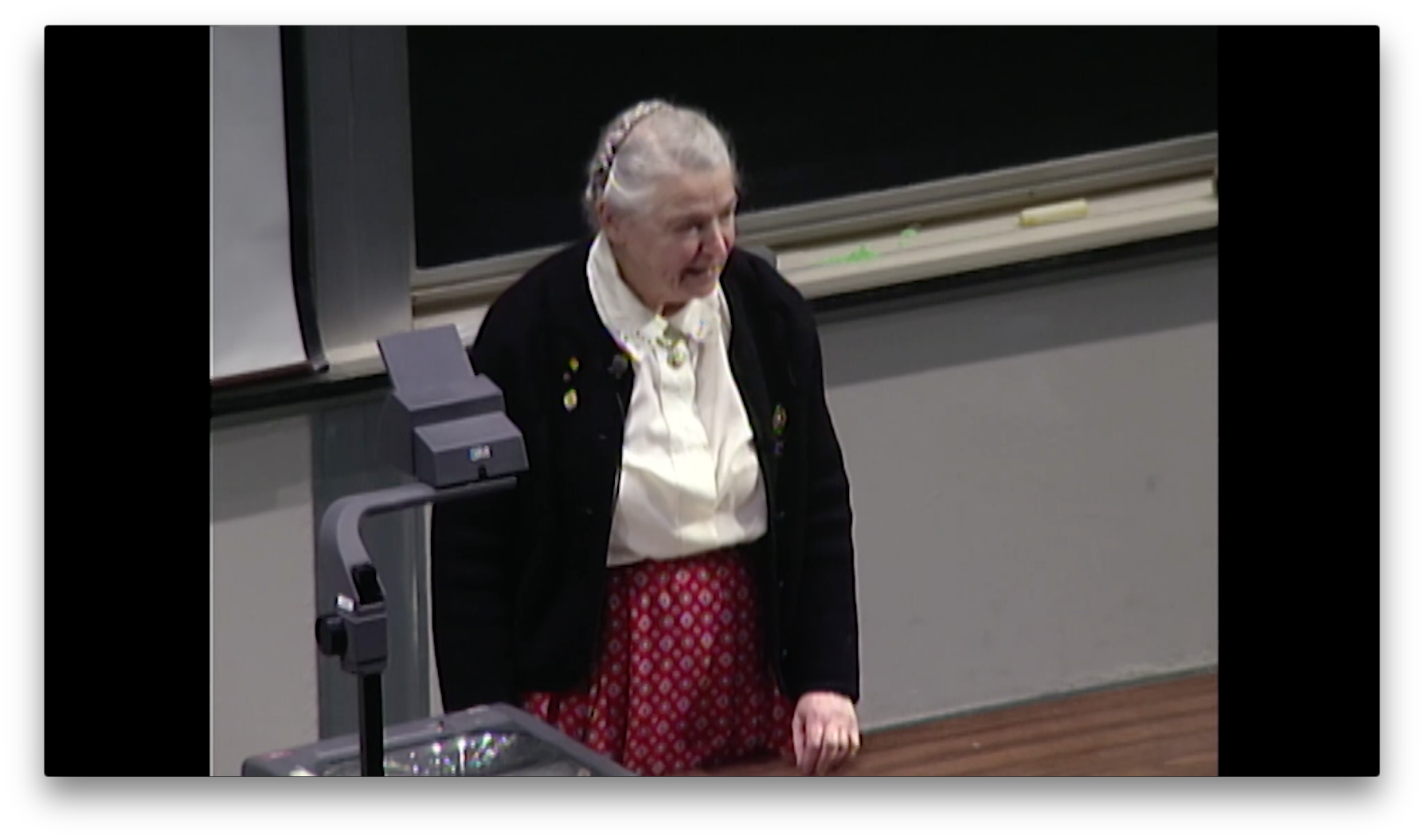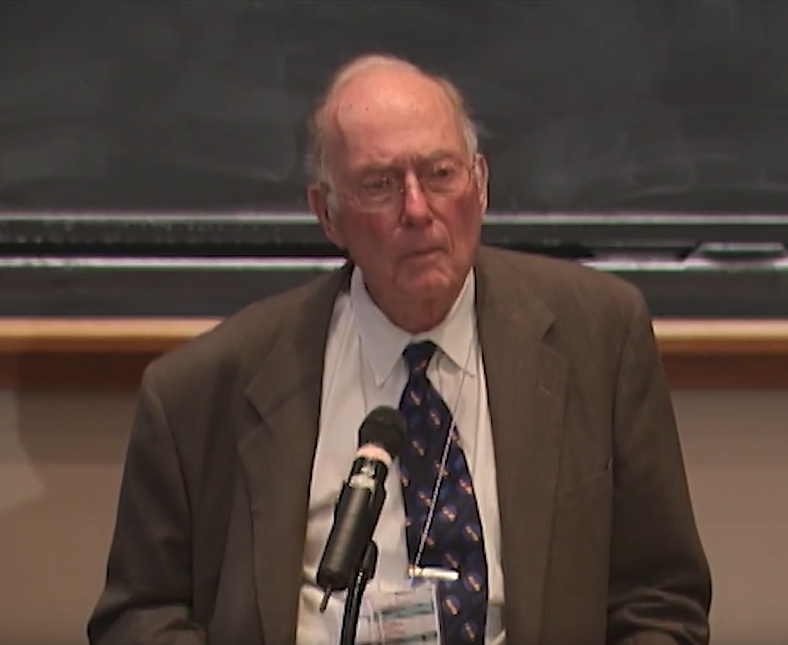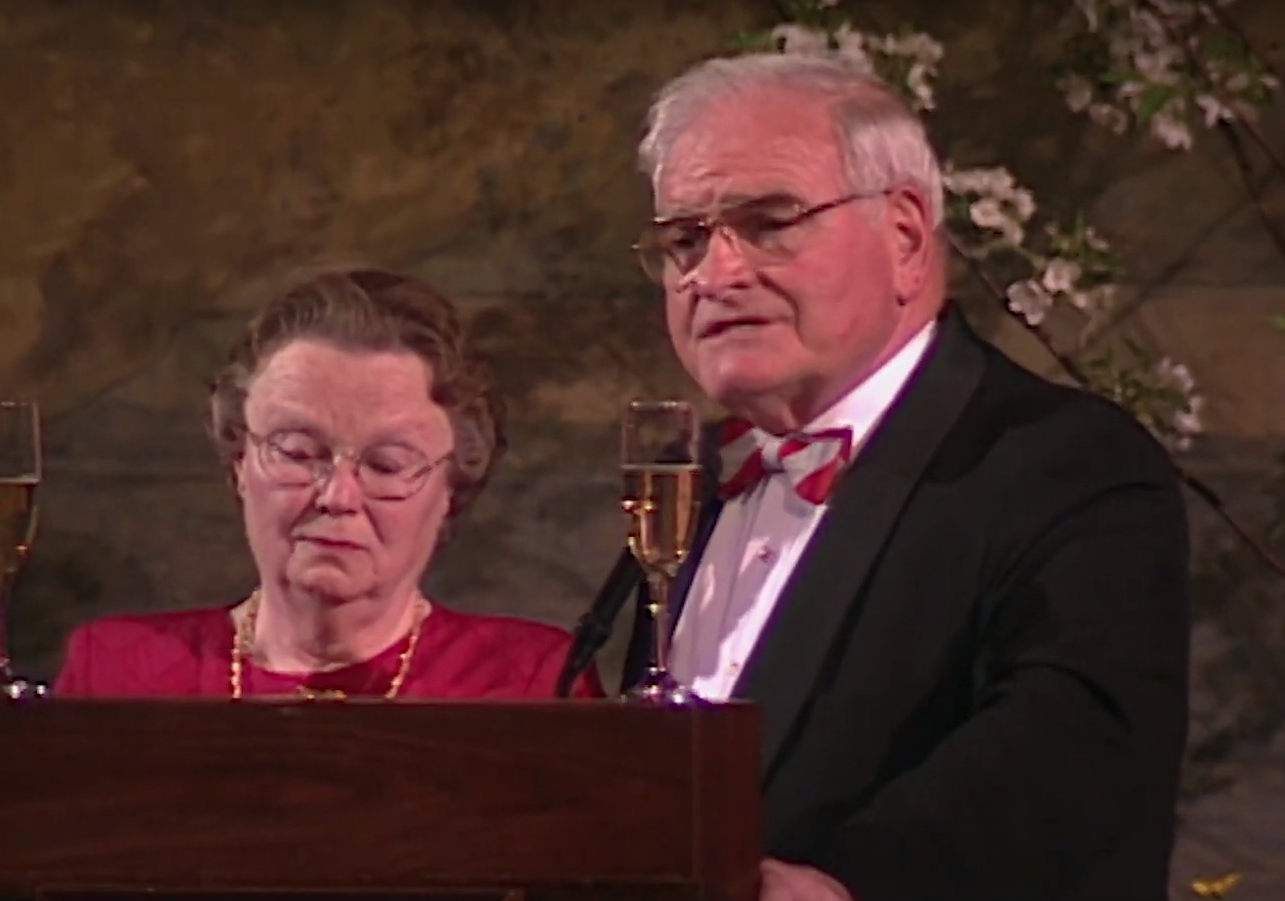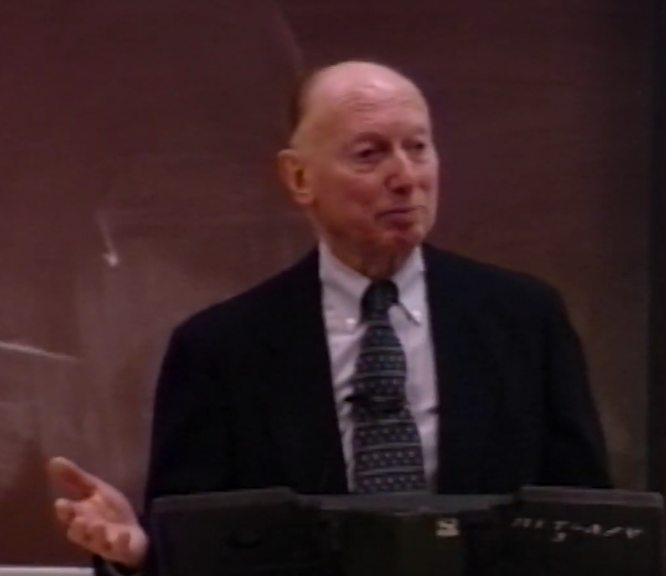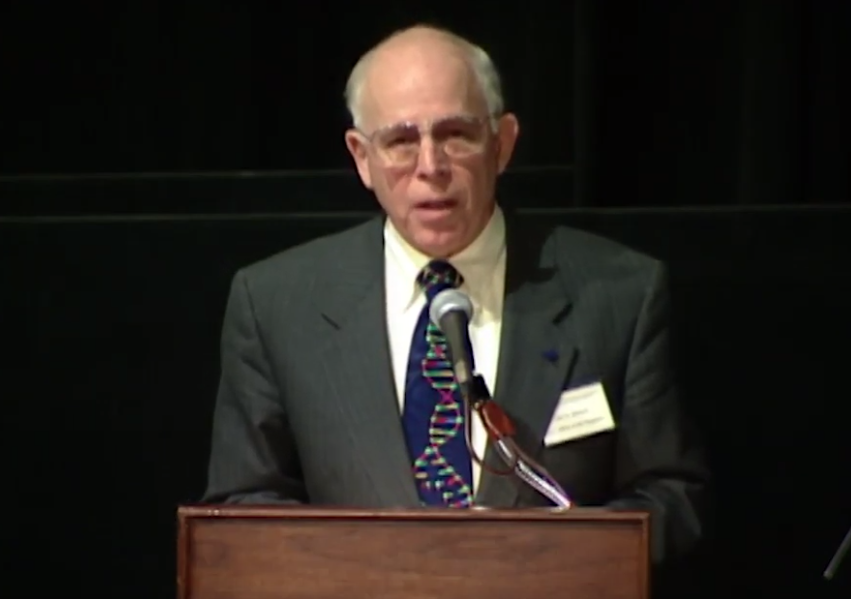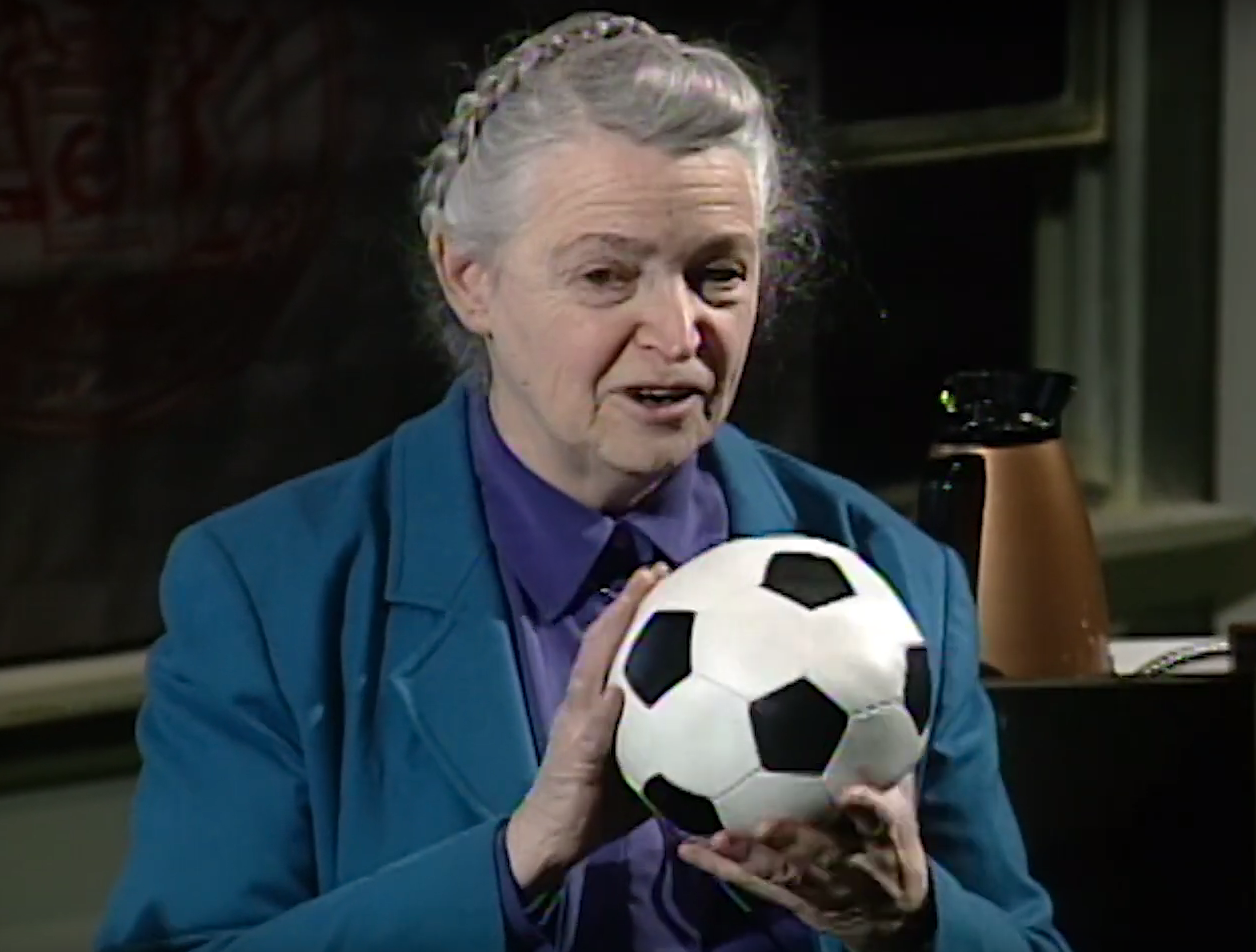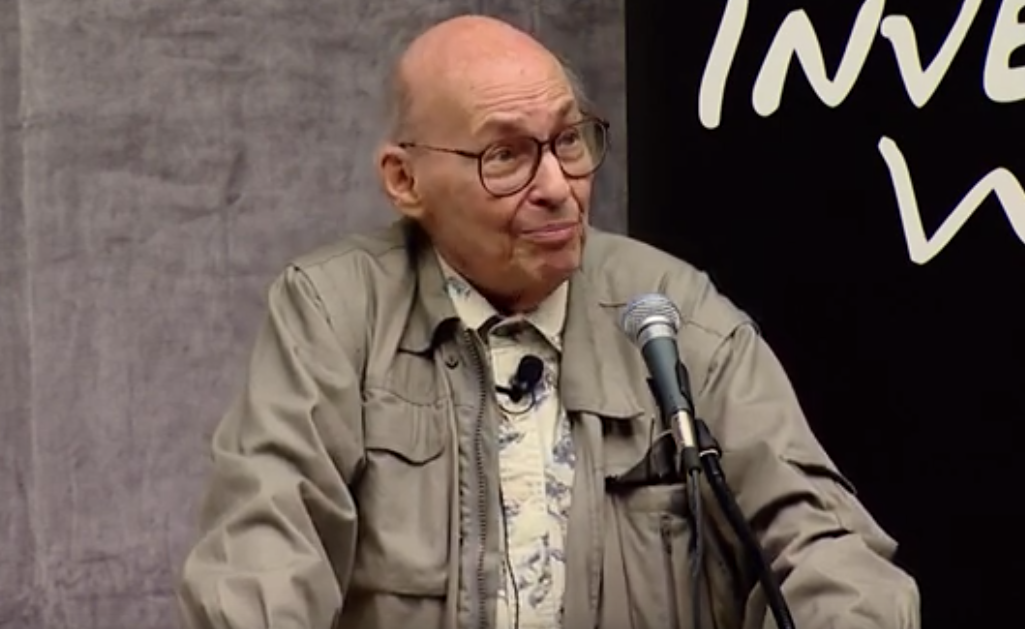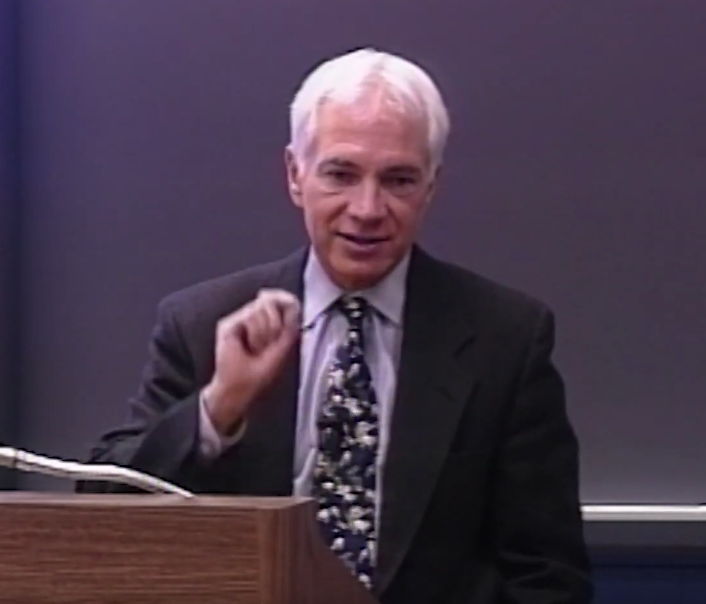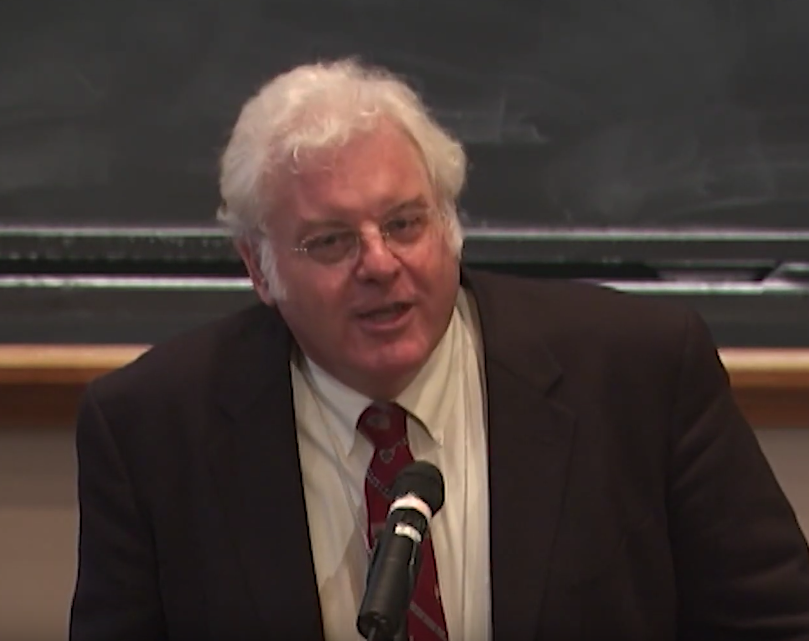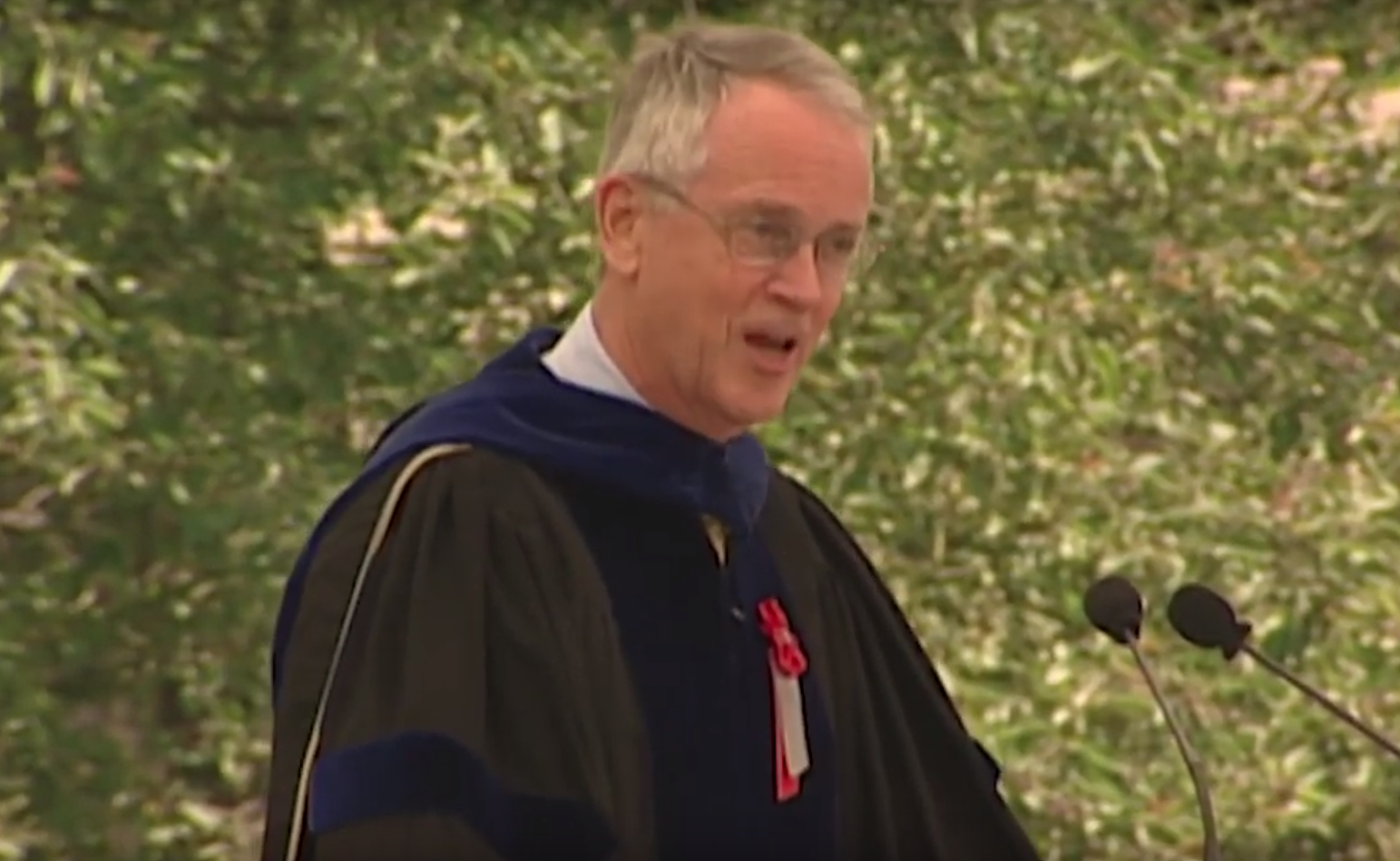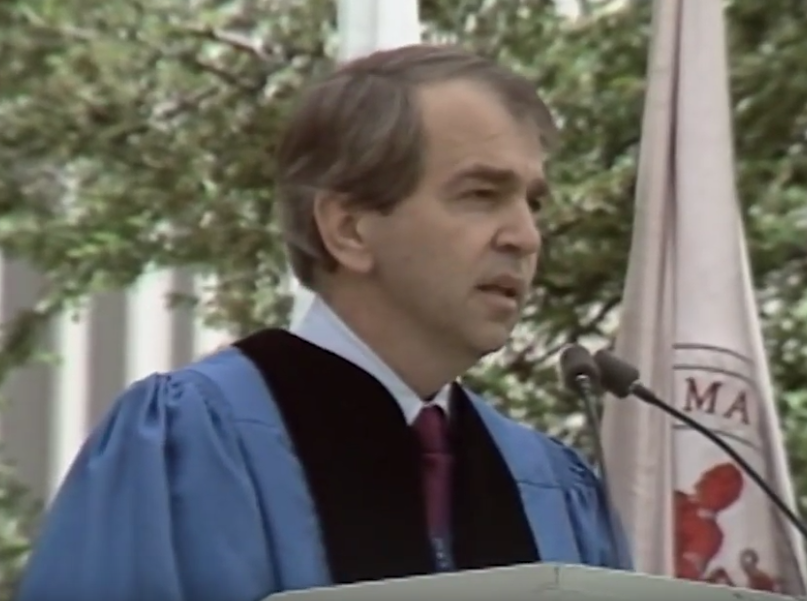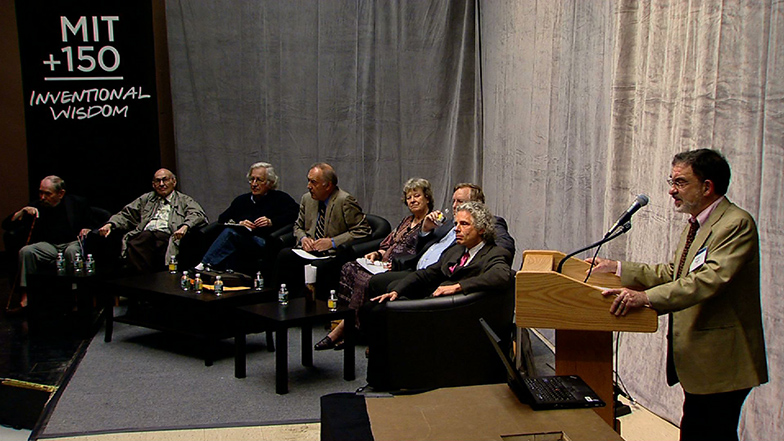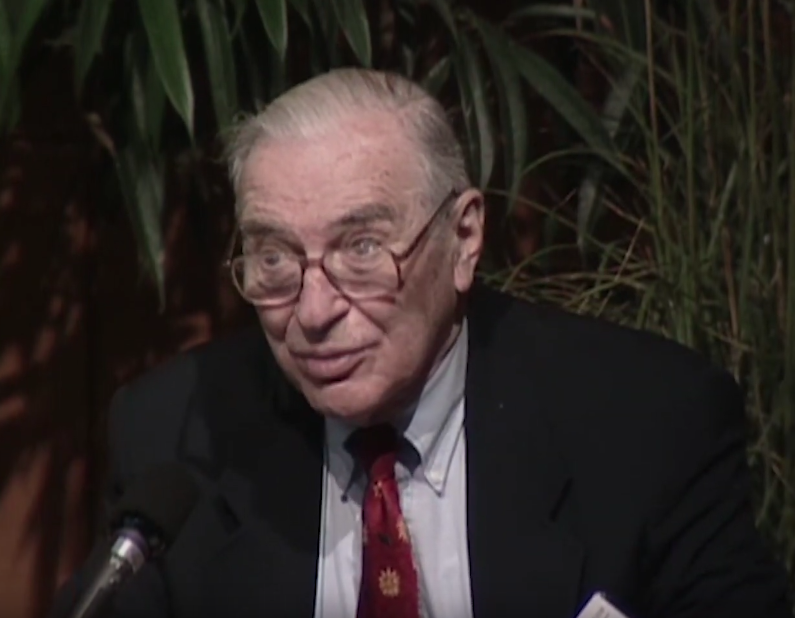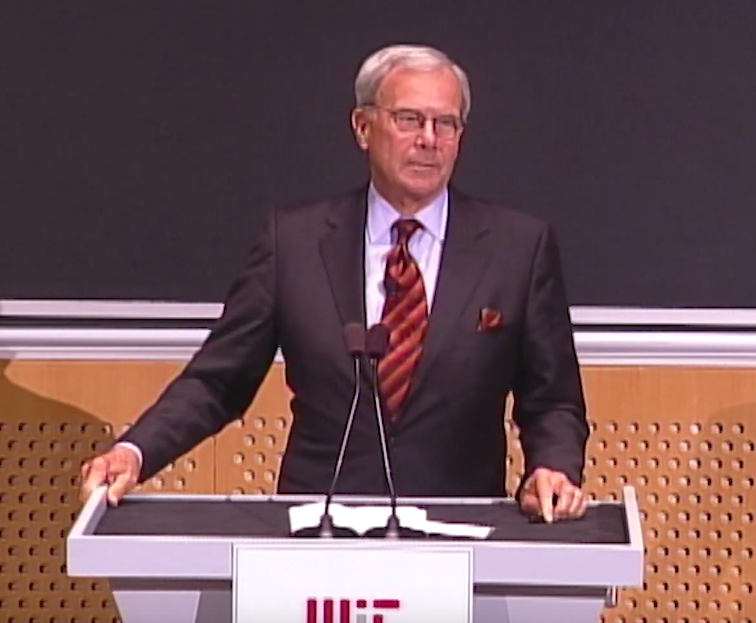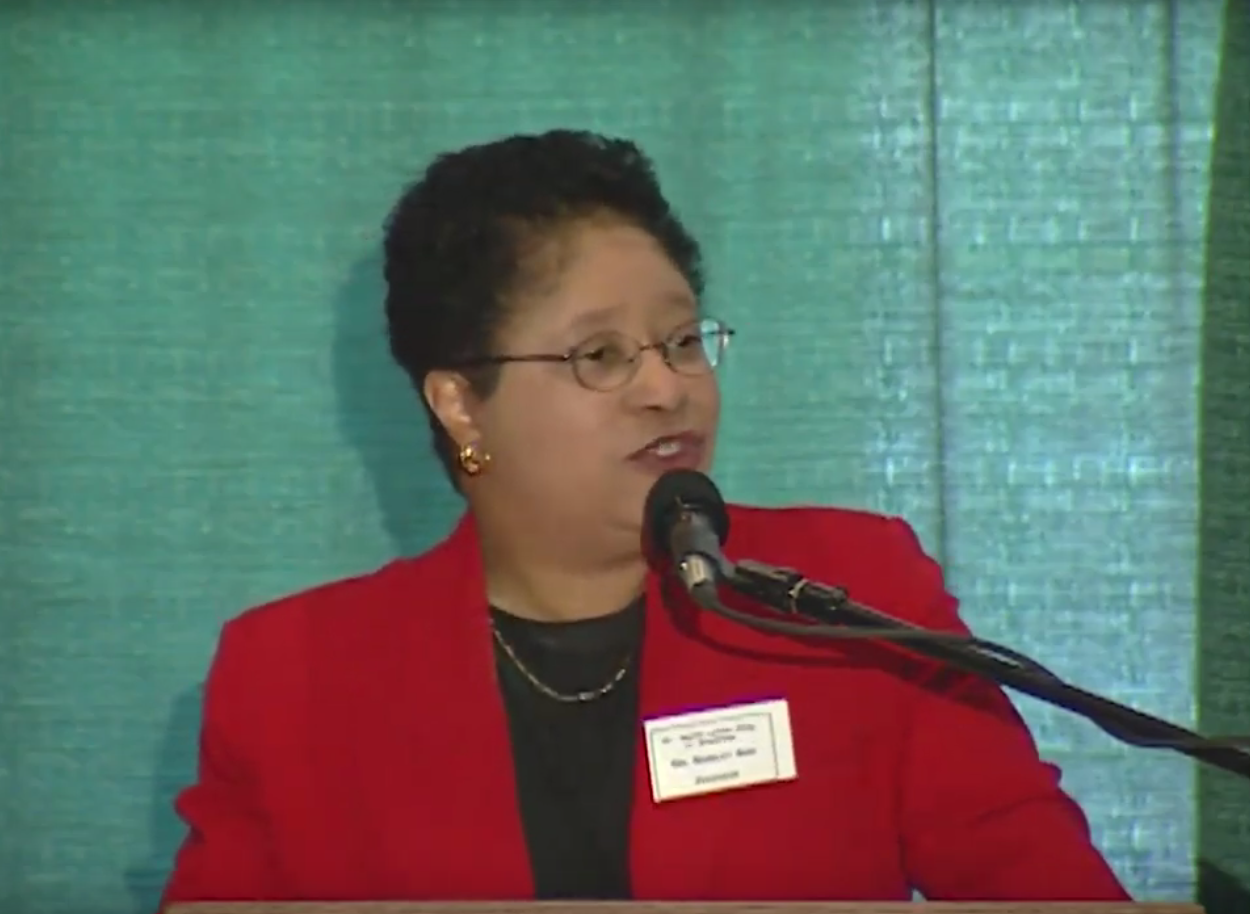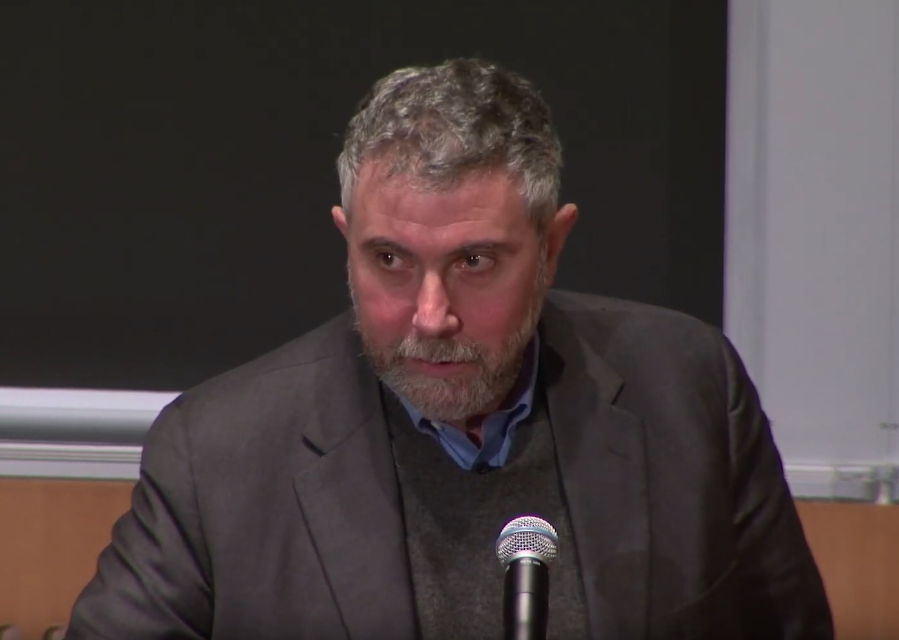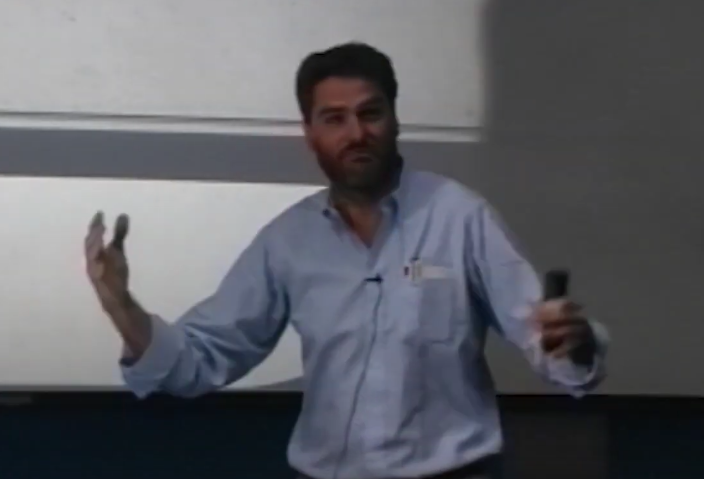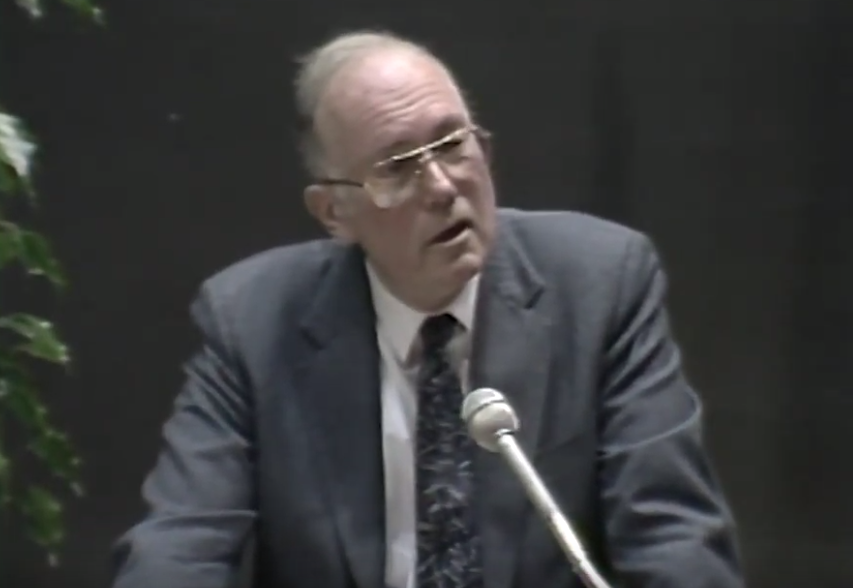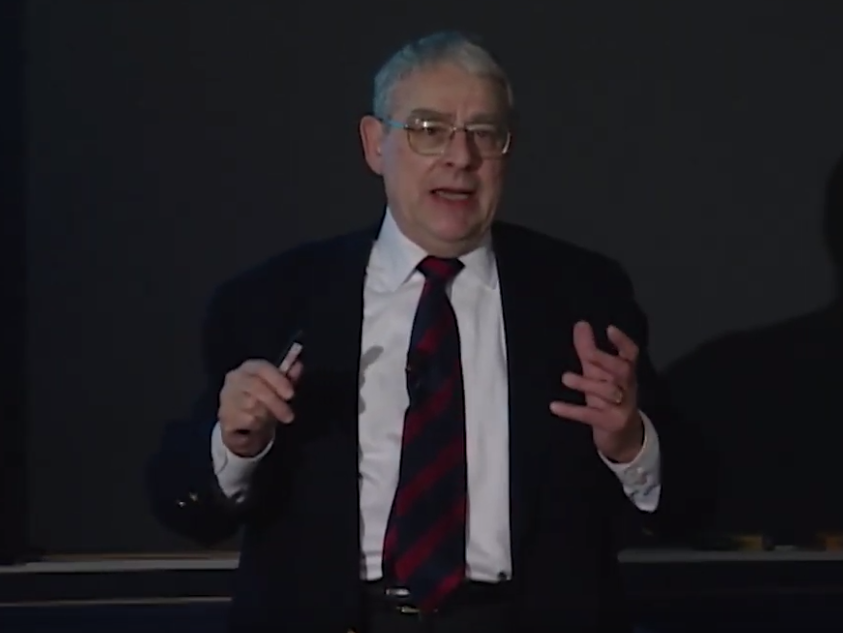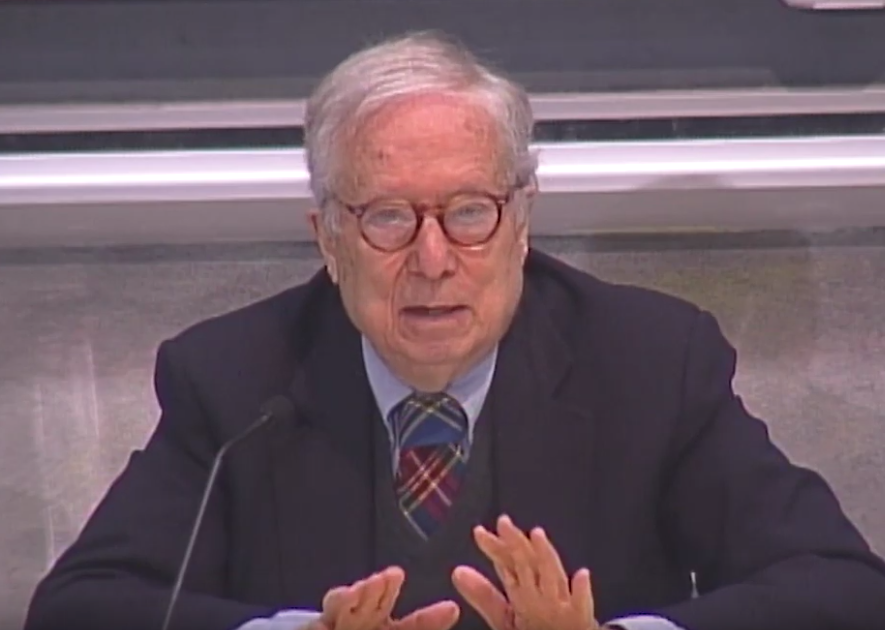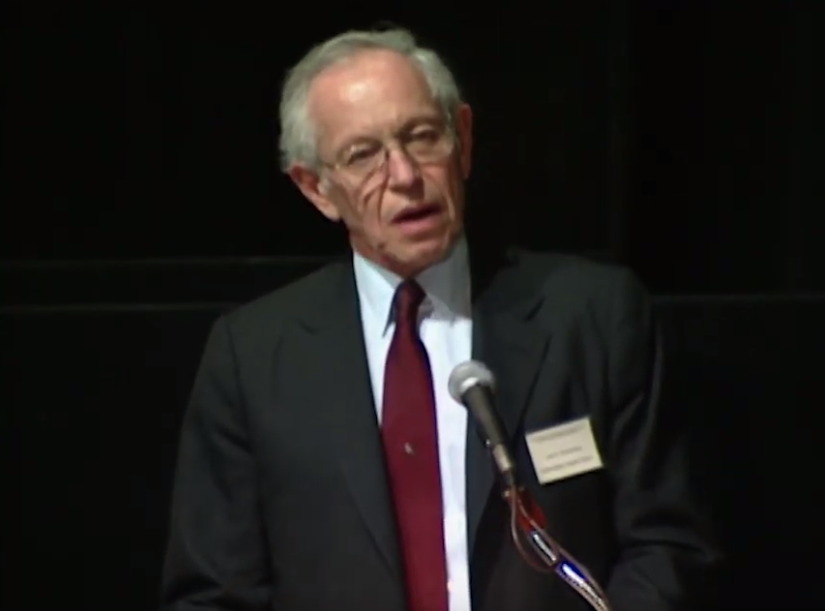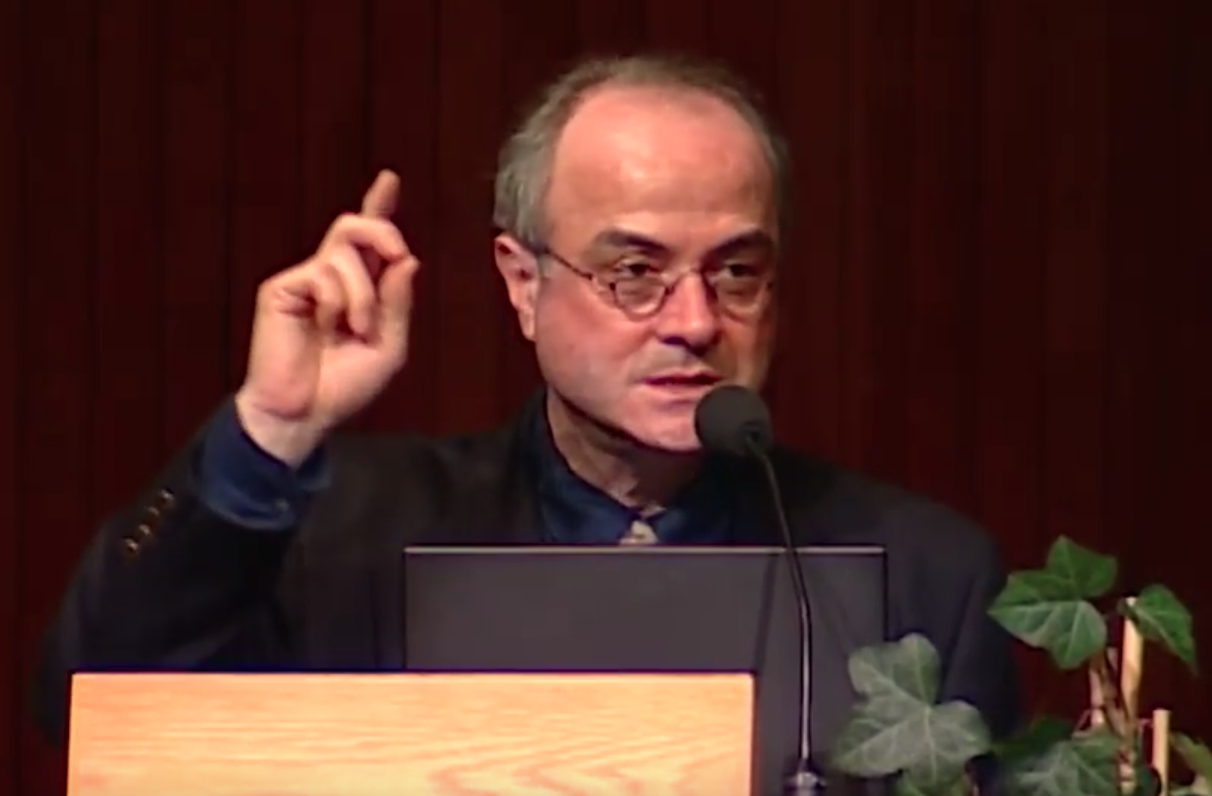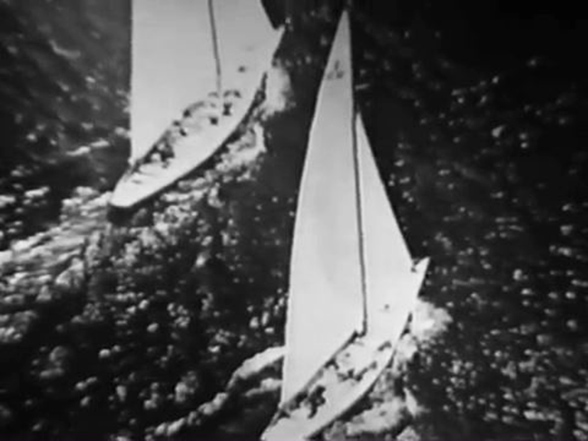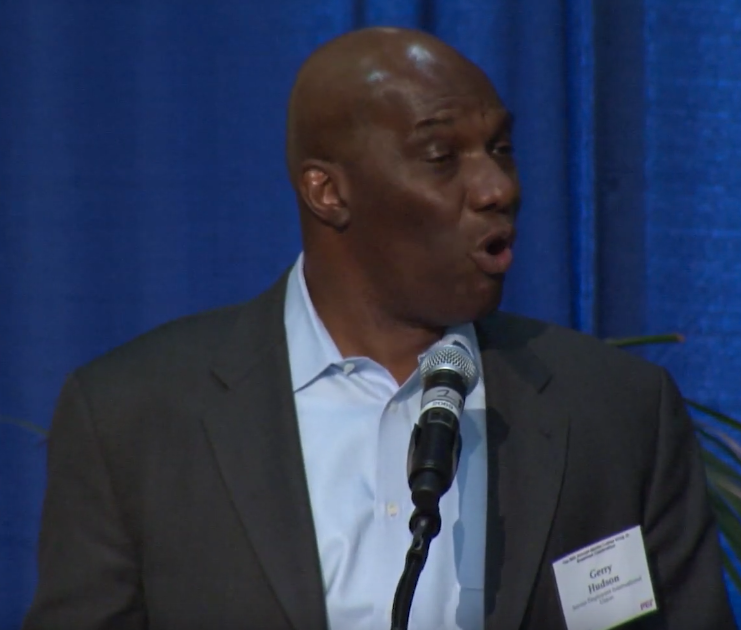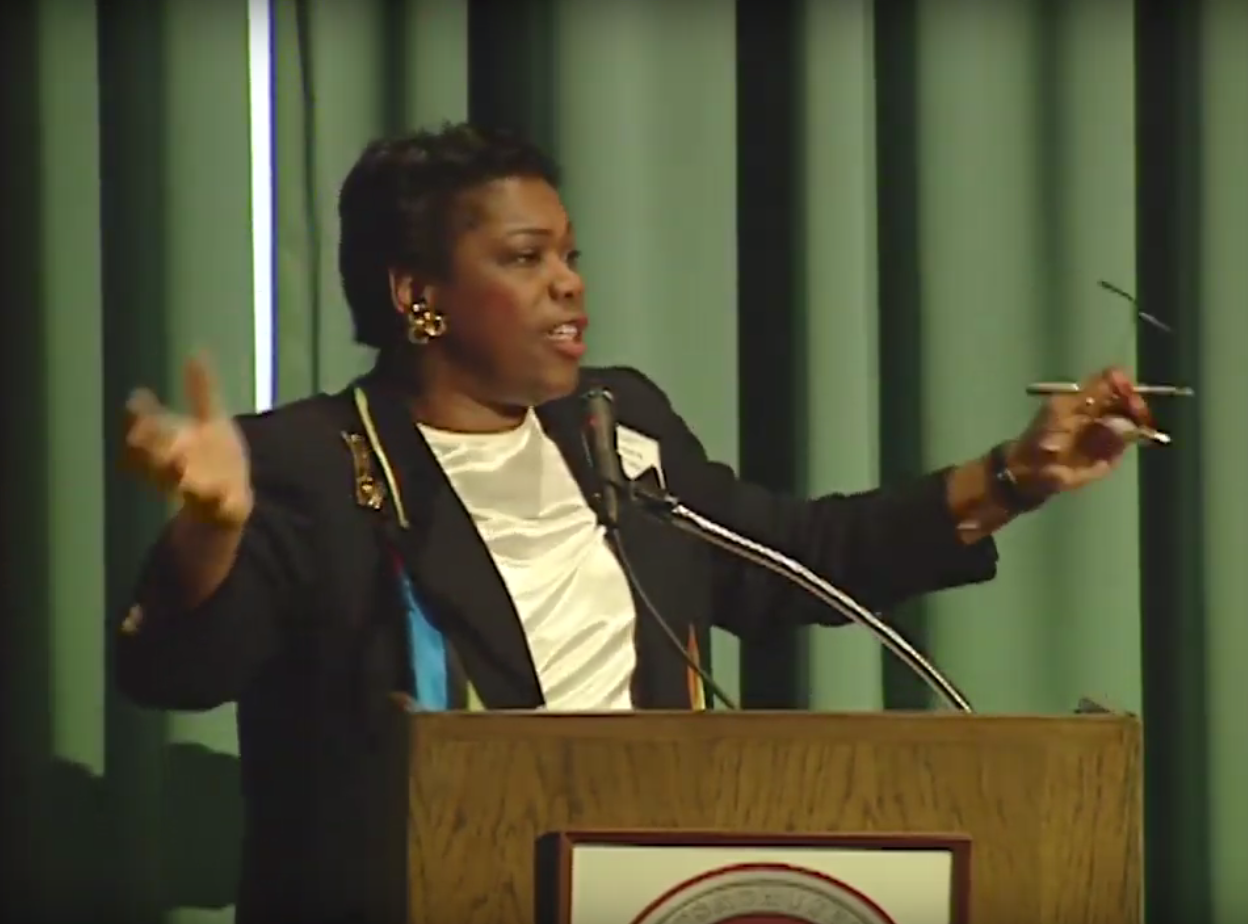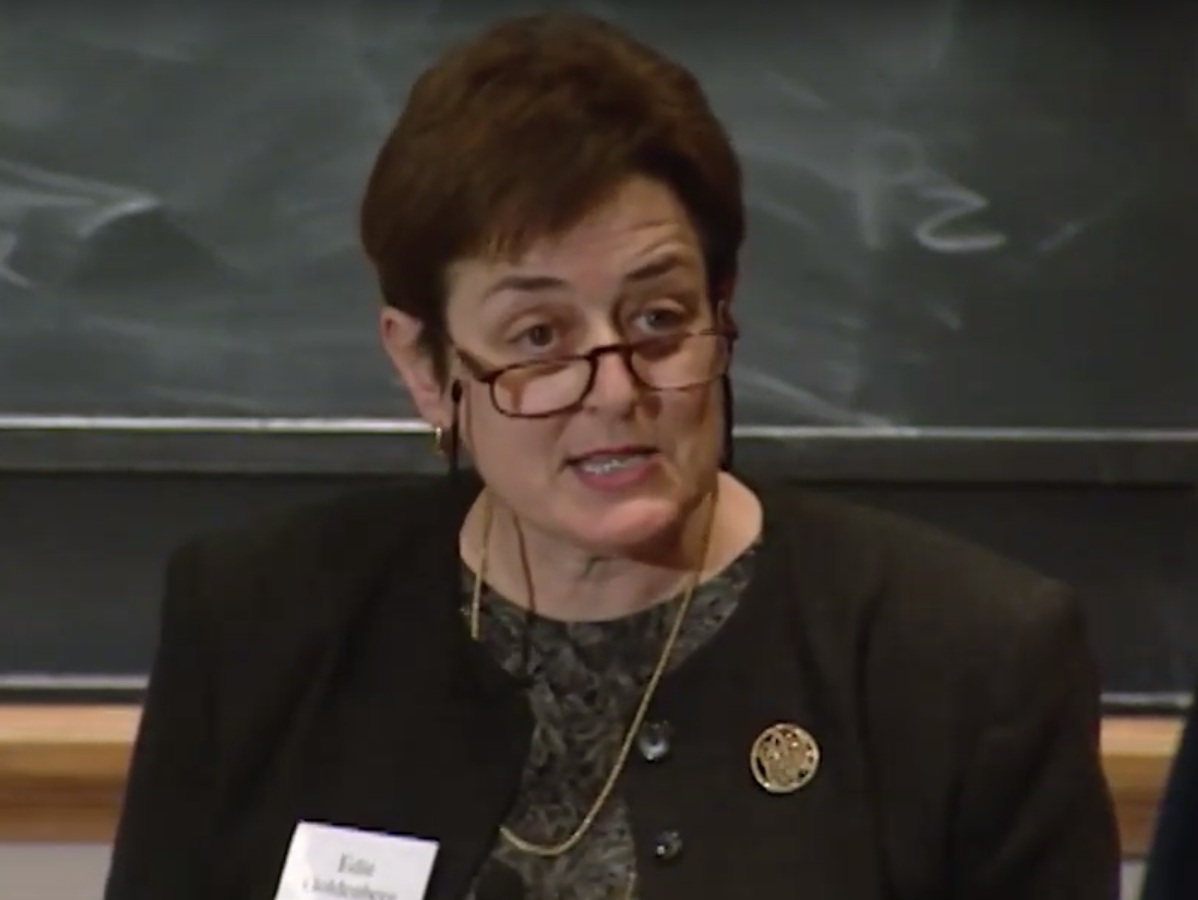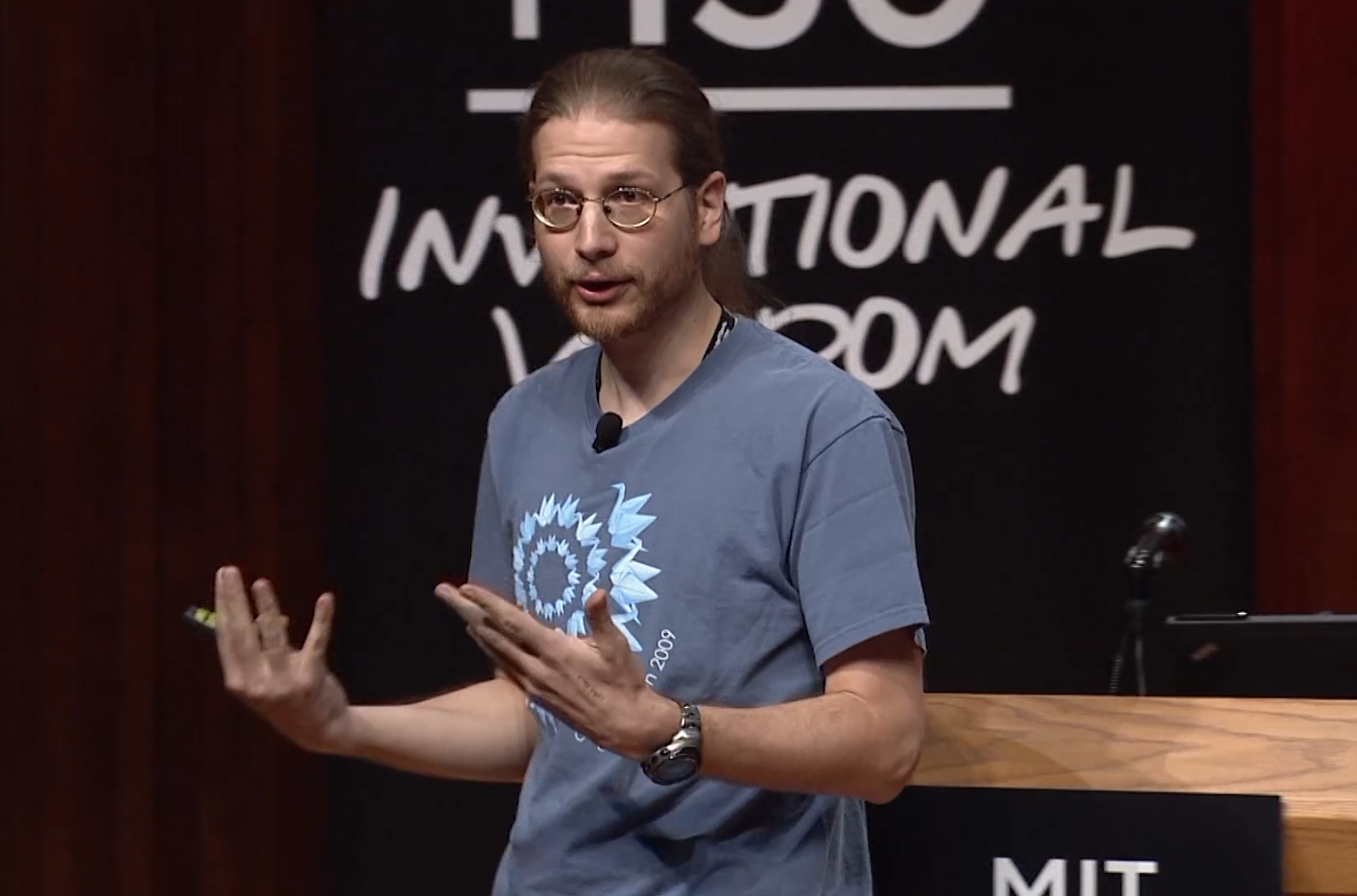Technology Day 1996—"Miracle or Mirage: Technology at the Horizon"
BILL HECHT: For the handful of you who are not people I know, my name is Bill Hecht. I'm a member of the class of 1961. And I'm here not as a member of that class, but as your Executive Vice President. As Executive Vice President, one of the things I've come to learn is that all alumni are created equal. MIT does an evenhanded job on all of us-- hard maybe, but evenhanded. On the other hand, one of the things I say is a member of the class of '61 is that sixes and ones are a little more equal than the rest of us.
For those of you who are my age and older, welcome back to Saturday class. We actually have never tried to do commencement and reunions this closely together. And the fact that we've survived so far means it's done OK. We hope that you'll give us your feedback about this event, and we expect that we will try it again next year, unless the feedback is really terrible. And if it's a workable pattern, we'll keep going.
In order to run something like this, there are huge numbers of people involved, lots of volunteers, many of you in the audience who did that, physical plant, housing and dining, all of the campus activities people-- lots and lots of people. It's like a great big orchestra. But an orchestra needs a leader, and I want to pay credit to our two leader, and their Susan Thomases and Beth Garvin of my staff. I hope they're out there, and if not, let's give them a round of applause anyway.
[APPLAUSE]
My principal job, in addition to getting you to sit down and stop milling, which I've done, is to introduce one of my favorite honorary alumni, MIT's 15th President Chuck Vest. Chuck, to those of us on the campus, has become an extraordinary leader not only on the campus, but all of you should know an extraordinary leader of the research university community in America. He really has become the spokesman in Washington for this treasure we have in the United States, a treasure that every other national country would pay dearly to have to have-- this precious group of research universities, who've led to accomplishments and achievements. And we're at a very interesting watershed.
The federal government is changing. That's probably a good thing; it should. But the question is, how should it change, and how will it continue to support this great effort? Chuck has literally become, initially single-handedly and now, thank goodness, with a reasonable amount of help from industrial colleagues and other university leaders, the person who's led the charge for the value and the extraordinary importance to our society, both in terms of economics, in terms of human resources, in terms of education, of the research university complex. So join me in welcoming Chuck Vest, 15th President of MIT.
[APPLAUSE]
CHARLES M. VEST: Thank you very much, Bill, and good morning, everybody. I understand that we have around 2,500 alumni, alumnae family and friends who have come back for our reunion and especially for Technology Day activities this year. And I think that is really just a terrific. Beyond that, this is a very special Technology Day, in that it comes just one day after commencement.
Ordinarily, as you know, a week elapses between commencement and the beginning of our alumni and alumnae week activities. So this year as provided a wonderful opportunity for you to mingle with those are just beginning their post-baccalaureate journey. It's an experiment, as Bill has said. We intend to repeat it, unless we hear something different from you, but we are interested in your reactions to this new format.
Now, we have a really exciting day ahead of us. The speakers for today's program are truly a stellar group of men and women, who are going to talk to us about the future. And Bill was mentioning getting messages out to the government, to the public, and one of the important messages, of course, is that the blessings of technology that we benefit from today, in terms of quality of life, in terms of health care, of security, of the economy, and so forth, are purely and simply the result of past investments in fundamental scientific and technological research. Similarly, the quality of life tomorrow is going to depend on the investments that we make today. And that's something that I hope all of you will keep in mind as we wend our way through this remarkable program.
I want to take just a moment to indicate some special thanks. They go to Ron Fergle, who has served as the chair of this year's Technology Day Committee, and to the rest of the committee for putting together such an excellent program. Now, knowing that this is MIT, I'm not going to ask you to applaud yet because I know you want to see the product of their work. But I can guarantee it's going to be good.
Now, two years ago, we were sitting around in a meeting talking about messages and how to communicate the importance of MIT to our nation and to our world. And with all due respect in my voice, so don't misunderstand that, I sort of thumped down on the table, and I said, well, one thing we've got to stop doing is spending all of our time talking about how we won World War II. We've got to talk a little bit about the future.
Whereupon Paul Gray leaned over and whispered in my ear and said, guess what the theme for this year's Technology Day is going to be? It's going to be MIT'S Role in World War II. Well, we gad that last year. And, of course, it really was very, very wonderful and did remind us about where we have come, what we have meant to this nation and world in the past. And so I think it's fitting that today we, with that as our background, turn now to look toward the future, the thing that MIT really, in my view, specializes in.
This morning's session will give us both a broad view of the future and a look at new developments in biology, in materials and recycling thereof, in communications and information technology-- three very important themes. This afternoon, following our traditional luncheon, there will be panel discussions that we'll look at the changes that technology is likely to have on emerging businesses, culture, on education, and the economy. Now, I say "likely to have" because we can never know with absolute certainty, of course, just where our science and indeed our technology will lead us.
But with a firm result to act responsibly, we must press ahead, as our Vice President reminded us yesterday. We must press ahead into the realm of the unknown simply because there is so much to be explored and to be known. Earlier in this year, in the annual President's Report, I touched on this them, and it was astounding the instant interest that the media had not only in the United States, but in countries all over the world.
What they found newsworthy, I suppose, was that the president of MIT had actually publicly acknowledged that there's still a few things that our faculty actually don't know. Indeed, when the Washington Post reprinted a portion of these thoughts on its op-ed page. The Post headline writer described the list of unknowns as, quote, "an agenda of ignorance for the next generation of geniuses to chew on." I really like that.
In this annual report, which, I in fact, wrote with the help of quite a few faculty members here at the Institute, I noted that unanswered questions are the single most valuable thing that we lay before our students, and that we must remind ourselves and we must remind the public that our value to practical concerns, like health, productivity, the economy, and national security, accrues ultimately from our enthusiasm for mysteries, our readiness and the readiness of our students to explore the truly unknown.
To come up with just a tiny sampling of the many puzzles that MIT is trying to solve, I turn to our faculty, as I said, for suggestions, and they had no difficulty in naming numerous areas of research, replete with very, very basic unknowns-- the mind, energy, health, climate, the cosmos, economics, information technology, and so forth. In the category of mind, for instance, we do not really know how we learn or remember, how we think, how we communicate.
In terms of energy, we do not really know how to convert solar energy into practical cost-efficient fuels for a wide variety of applications. Nor do we know how to create advanced fuels for nuclear fission reactors. In the field of health, we do not know all the details of each specific gene and the mutations thereof, how exactly how they contribute to the development of cancer, but we're learning. Nor do we understand all of the mechanisms that underlie it.
As far as climate, we do not know, even in principle, what aspects of climate are, in fact, fundamentally predictable. And we find that even the most elaborate climate models, running on the most powerful computers, cannot reproduce today's climate without introducing truly uncomfortable levels of artificiality. The cosmos-- we still do not really know how old the universe is, what it is made of, or what its fate will be. We do not know of stars, other than our own sun, have Earth-like planets capable of sustaining life.
In economics, we do not know why national economies grow at such different rates, either at a particular moment in time or over the long sweep of history. And in the area of information, and you'll be hearing a lot about this this morning, we really don't know what the consequences will be for the future the nation-state, of the explosion in networked electronic communication. The internet, the world wide web, these are things truly quite unlike typical telephone communications, and they have the potential to create new societies that are entities, in and of themselves.
So "we do not know" is the operative phrase. We do not know, but, of course, at an institution like this, we must ever strive to learn. So the search and the thirst for knowledge continues. Many of the people you will hear from today, and those whose work propels him forward toward the seemingly ever-receding horizons of knowledge, they are energized, rather than daunted, by the challenges of the unknown. And now it's my distinct pleasure to introduce several of these people, those who will be our speakers on this morning's program. Following their talks, there will be an opportunity to ask some questions of them.
Known to all of us is Institute Professor David Baltimore, a Nobel laureate, who also has served as President of the Rockefeller University. David first came to MIT for graduate studies in the early 1960s, has gone on to become a leader in modern biological sciences and a spokesman nationally and internationally on scientific issues.
David joined the MIT faculty in 1968 and was the founding director of the Whitehead Institute in 1982. And I can tell you that in addition to his absolute world-class scientific capabilities, I think David has the greatest nose for scientific talent in young people that has ever existed on the face of the Earth, and that has been the reason that the Whitehead has grown so fantastically in its short history. Current research in David's laboratory covers three areas-- cancer-inducing viruses, the immune system, and infectious diseases. Professor Baltimore's topic will be "The Next Gene."
Another of our speakers this morning is John Preston, Co-director of the MIT Entrepreneurship Center and President and CEO of Quantum Energy Technologies. John's affiliation with MIT began in 1977, when he worked for the Industrial Liaison Program. He became Associate Director of the ILP, before leaving in 1980 to become President of Visual Communications Network, the pioneer of presentation graphics on personal computers.
He returned to the Institute in '86 to become Director of Technology Development. While he was in that post until 1995, MIT led all other universities in the number of patents, licenses, and spin-off companies. John Preston's topic this morning is "Materials-- something old, something new."
Professor Michael L. Dertouzos, Director of the Laboratory for Computer Science, the home base of the worldwide web, is the author or co-author of six books. One of them I think is familiar to all of you-- Made in America-- Regaining the Competitive Edge. This resulted from a study conducted by the MIT Commission on Industrial Productivity, which Michael chaired.
Professor Dertouzos is an adviser to US and European governments and to several high tech companies, focusing his efforts on architecture, uses, and impact of tomorrow's information infrastructures. Professor Dertouzos joined the faculty after receiving his PhD here in 1964. In 1968, he was the co-founder of Computek, Inc., a manufacturer of computer terminals, and was chairman of its board until 1974. I always like to kid Michael that it's well known that MIT has a provost and a president, but it also has an emperor. That's Michael. Mike's topic this morning is "The Information Age."
And finally, in keeping with the injunction that the last shall be first, our keynote speaker today will be Bran Ferren. Bran Ferren is Executive Vice President for Creative Technology and research and development with Walt Disney Imagineering. Mr. Ferren, who attended MIT in the early '70s, is a nationally recognized award-winning designer and technologist. He works in the theater, in film, special effects, product design, architecture, and the sciences.
Bran began working at Imagineering, which is the subsidiary of the Walt Disney Company, in 1993, after running his own firm since 1978. At Imagineering, he heads the Creative Technology Group. An inventor and implementer, Mr. Ferren has received multiple awards, including several from the Academy of Motion Picture Arts and Sciences.
Now, you will notice this morning that I very carefully avoided all attempts at humor because I don't like to be upstaged. And I think when you hear Bran talk, you'll know why I have said that. You're in for a real treat. Ladies and gentlemen, we now began the morning with Bran Ferren.
[APPLAUSE]
BRAN FERREN: OK, brace yourselves. You're going to find this is a very leading-edge sort of talk. It's completely non-linear. There's no point. There's no particular rhythm to it. And what I'm going to do is just talk a little bit about the things that I care about, relative to this world and the intersection of technology and the arts, which is where I spent a fair amount of time playing. And it's interesting to me to see how new professions are being spawned on a daily basis.
Last time I was here in Boston, it was for the Worldwide Web Conference. And I found myself in the situation, which often happens, of can you do a technology demonstration? And that's always kind of an interesting question-- can you do it? And they said, well, we'd really like to see something because the theme of all of this is interactivity. And some people, such as myself, get kind of a sinking feeling when you hear the theme is interactivity. And the idea was just let's show what the real state of the art is.
I agreed, and what I agree to do was a show system that combines vision, machine vision, the capability of not just seeing and identifying and avoiding colliding with objects, but understanding expressions, gestures of human beings, combining continuous speech recognition, the ability to work, to some extent, in about 2 and 1/2 languages and to be able to do this and derive emotional content from the speech train. Effectors, sensors, coupled to this so that you have a fully closed loop system, pretty state-of-the-art technology in neural nets, which tie it all together-- fuzzy logic, that sort of thing.
What I demonstrated was me. And I think it's important that we remember that I and you are the state-of-the-art in interactive technology, because all of this other junk we have, like computers, is really pretty primitive. And why does this matter to us in the world that I'm in? Because it's the thing called our audience or our guests. And understanding that is pretty fundamentally important.
The first kind of interactive consulting job I had when I left school was with the Canadian government. This was a big job. I'd been working in film and theater before that as well as doing some consumer product work. And the Canadian government called up and said, gee, we're doing this World's Fair. This phone call came in '85. The World's Far was called Expo 86, which gives you an idea of the planning horizon for these things. And they were looking for an interactivity consultant. I was recommended.
I arrived. I sat down in a meeting, where they explained to me that they were designing and building a "future choice" theater. This was a space where you would sit down. There would be a bunch of push buttons in front of you. You would see a film. You would press a button or two and select the ending of the future that the will of the room thought was appropriate.
They wanted for me-- and I was expecting that they wanted my deep philosophical insight into the humanistic values and the vision of the future. What they actually wanted from me was to know how to wire up all the boxes. And I thought about it carefully, proposed to them that what they do is install all the boxes, don't connect them to anything, ask a question, flash a few numbers on the screen, and then just run a different ending every so often.
[LAUGHTER]
[APPLAUSE]
They accused me of having a bad attitude. But I maintained that there was no difference whether you connected them or disconnected them. It's a sort of a Turing test for the value of interactivity. If you can't tell whether the boxes are connected or not, in that sort of situation, if you've got the ending you picked, it's because all of the insightful, clever people surrounding you joined you in your button-pushing quest. And if you didn't get the ending, it's because all of the morons that they let in during this show clearly just don't know where it's at.
So part of the problem with this is you have to understand the people like me believe that story is everything, and the act of storytelling, which I would argue that storytelling is probably the world's oldest profession, contrary to what you've heard, and that you don't get misled in all of this by hearing about interactive movies. Interactive movies is a dumb idea. The reason you go to a movie is because you want the point of view of the director, the writers, the other people that were assembled to present this film to you.
If you went to see Schindler's List, and you had a knob installed that let you dial in "happy Nazis" or some other set of phenomena, I guarantee you it wouldn't be a better film. You go there because you want someone else to tell you a story, because presumably, they're good at it. And simply saying, well, gee, we'll let you pick the ending or direct the film, the reason Steven Spielberg gets paid $10 million to direct a film is he's better at it than you are. And for sort of the same reason you don't want an interactive medical experience, where basically--
[LAUGHTER]
I would argue that the same thing pertains to storytelling. It's interesting because if you go to a typical multimedia conference, and at the moment, there seem to be one-- they're happening at about the same rate that McDonald's are being built, about one every 11 hours, I think, in the world. And at some point, someone will announce that they understand the killer app, and the room gets very quiet, the sort of shuffling stops. Japanese tape recorders are thrust into the air in the general direction of the speaker. And what we then hear is generally sort of a breathless word, "content," and there's a stunned silence of the room.
Everyone breaks into a round of applause, and it is acknowledged that the future of multimedia technology will be content-based. Now, if you went to a booksellers conference and said. I finally figured it out. It's content. It's not the bindings. It's not--
[LAUGHTER]
It's not the slope of your serif. It's not a bunch of other things. They would throw you off the stage. You do this at a multimedia conference, and somehow or other when it comes to areas of technology, everybody lose their minds, and you get great rounds of applause. I think part of the challenge in all of this is understanding what is real. And when you're looking into the future, it's difficult because there is no simple answer.
And, in fact, if you're doing something new, generally speaking, I found that, as a designer, if people came to you and said, we have a really challenging project for you, it meant three things were consistent. It meant one, they had no money. It meant, two, there was no time to do an adequate job. And they would usually say, and we want something completely unique and different that nobody has ever seen before. This meant that they wanted to see three examples exactly like it, so they could be sure that it was going to work.
Now, part of the challenge is how do you, in fact, make decisions about the future, when you're in a job, such as what a lot of us do, which is guiding the future, what horse do you bet on? And it's an interesting challenge because what we constantly are presented with, with technology, is solutions often in search of problems.
HDTV, High Definition Television, is a good example of that. Remember HDTV? HDTV was kind of an interesting phenomena because it was proposed as being the solution to the problem of television as we know it. Now, anyone who thinks that the problem with television is the number of horizontal scanning lines, rather than the lines of dialogue spoken by the people on screen, are watching a different type of television than I am. And how many times have you watched TV show and said, gee, that was really spectacular, but if it only had another 622 horizontal scanning lines, it really would have changed my life?
[LAUGHTER]
Part of the problem here is that people miss the point about when you take an advanced interactive system, like a human being, and put them in a storytelling mode, what you are actually doing. And this is where, often, the storyteller's role and the artist's role and the scientist's role are sometimes in conflict and speaking different languages. For example, there is a type of resolution that goes well beyond technical resolution and is critically important when you are communicating ideas to people.
By technical resolution, I mean, if we talk about, let's say, an imaging problem, it is common to have the scientist, now that we're talking about digital imaging, say, well, what are the requirements of this system? What's the resolution? How many pixels are there going to be? Spatial resolution-- how sharp do we want the image to be. Chromatic resolution-- what's the color depth, what's the grayscale. How often do we update it-- temporal resolution.
The fact is there's this really important thing called emotional resolution. Now, it's difficult to talk about emotional resolution because it is a purely qualitative idea, and often the people that have to hear about most are purely quantitative people. And you'll say, you know, this is a completely qualitative idea. You just have to get the feel for it. At which point, they'll listen to it and say, yes, but can we have like an ETF, an Emotional Transfer Function, that lets us assign a number to this that we can understand?
Let me tell me a little but what I mean by it. Think back at what you remember for your entire life that you saw on television, for example, just picking one communication channel. I can think back when I was a child, I was in Norway with my parents. I'm not Norwegian. I was on vacation in Norway. And we were sitting in a pub or a bar or the equivalent having lunch, and up in the corner of the bar on the screen, was a blurry image, light blob moving diagonally across the screen, a lot of static. And I watched this and heard words that I will never forget till the day I die. And they were, "one small step for [STATIC SOUND] one [? stict ?] kind." I will never forget these words.
The mere fact that they were inaudible and incomprehensible didn't matter because Walter Cronkite came on shortly thereafter and explained what Neil Armstrong and the boys had basically said. And the entire planet was transfixed watching this. And even though the resolution of the image was such that I probably could have done a more credible job with a sheet and a flashlight in my bedroom, the fact is that it didn't matter because while the technical resolution of the data link was quite low. The emotional resolution of what was going on was extraordinarily high.
I remember when the President of the United States John Fitzgerald Kennedy was shot. And I was a child, and I was in school. I didn't really know what was going on. I'd never heard the word "assassination" before. But I knew from that moment on everything had changed. Everything about our country, about our class, about the people had changed. I didn't understand or begin to understand-- I'm not sure I still understand it-- till much later. But my sense was that something happened, and something profound happened. And again, technical resolution was not high of what was going. And the fact is it doesn't matter because the emotional resolution was high And you say, well, this is all well and good, but you're just talking about these kind of dramatic things. Well, dramatic things are an important part of our lives.
But more to the point, if you look at what a cinematographer does in this day and age-- cinematographer, a cameraman and a film-- he's charged with taking $50 to $100 million and telling stories with beautiful images. He will go get the best technical equipment that captures images on the face of the Earth. And he and she will take this, have their assistant test it, verify its performance, color match it, calibrate it, take lenses costing $50 to $100,000 on a camera costing a half million to a million dollars. By the time they're done with testing, this is the state-of-the-art technology for capturing images.
You bring it to the set. You put an actor in front of it. This is usually the way it's done. And the actor can be making, typically, now the high watermark is $20 million plus a participation in the profits, which is usually when most people in the audience say, engineering? Anyway-- and an interesting thing takes place; this director making $10 million, this actor making $20 million, a few other actors, all of these professionals come together. Just before you're ready to shoot the first scene, an interesting phenomena takes place.
The director of photography whispers to their first assistant, who comes over with a little box. The box is opened up. They take out a diffusion filter. They put it on the front of the lens. They take out a clear piece of glass, take some nose grease and start rubbing it into the edge of the-- if you have a dry nose, Vaseline will suffice, but usually nose grease. You'll take a lady's stocking. You'll stretch it over it. You'll throw a few pink lights over here. You'll put an amber gel over here.
By the time you're ready to shoot, you have lowered the technical performance of the system to the equivalent of a disposable $5 camera or worse. And why have you done this? Very simply because increasing the resolution photographing a movie star, doesn't help tell stories. And 11-foot diameter nostril, by the time it appears on the screen, showing every pore and every hair, showing the color difference where the makeup comes around the side of the face doesn't make for good storytelling. And, in fact, there's a range over which you increase the resolution of the system and you decrease the ability to tell effective stories. And part of what we do in our side of the business is learn how to balance these things.
We are living at an amazing time in history. After coming through a pretty boring time in history, the '80s, not very much happened in the '80s. It was a difficult period. It was a period of time where children were taught to look up to Donald Trump-- go figure. There are two technologies on the horizon, wide band networks and virtual reality, which are going to change the world. And they're going to do it in a permanent and profound way.
How can I say this? How many of you are on the worldwide web out there? Pretty fair bunch. The rest of you should get with the program. But why do we think that this world wide web is anything more than citizens band radio? Why do we think that this isn't going to be something which is a flash-in-the-pan, which disappears? Why isn't it going to be quadraphonic sound or eight-track tape?
I think to answer these questions and understanding that for something to become important, you are competing for the two most valuable things that a person has. And those two most valuable things are time and money. When you're young, money is where it's at. That is the most valuable thing. About five minutes before you drop dead, time seems like a pretty important quantity. And so there's this sort of sliding scale between time and money. But that's what you compete for, if you're going to add value to people's lives. And to look at this, how do you determine which is going to be citizens band and which is going to be something that is deeply profound?
I think to do this, you have to look back in history. And I'm going to take you on a very brief historical tour. You have to understand that evangelizing about how this technology is going to change the world, it's a little like trying to talk to the Wright brothers about the advantage mileage program and why it would be a sound strategy for their future business. It's just hard to get the context going.
Let's look into history. What, since the beginning of our specie, human beings, what were the really important things that changed our way of doing everything? What would you say is the first big invention? This is the interactive part.
AUDIENCE: Fire.
BRAN FERREN: Fire.
AUDIENCE: Wheel.
BRAN FERREN: Wheel.
AUDIENCE: Writing.
BRAN FERREN: A lot of technologists here. Writing. Earlier? Language-- language was a very useful invention. Before language, we did a lot of grunting and groaning. And while that is useful and effective for a certain range of things we have to accomplish in our lives, to build a society, you need more. And language-- and shortly following language, storytelling, and you could argue which came first, meaning the notion of how you organize ideas in such a way that you can communicate them to people.
Language was the first big protocol debate. It was the first big standards war. Because people will learn to communicate if they just grow up together. The fact is they don't interoperate terribly well that way with other people. And so language was pretty important. It clearly started people coming together and being able to work cooperatively.
What was the next big one?
AUDIENCE: [INTERPOSING VOICES].
BRAN FERREN: Writing-- writing was important. Clearly, before writing, anytime someone dropped dead, a lot of information was lost. This gets a little old. You have to wait another 300 years to find fire again. And there was a lot of protectionism, even then. And so we basically needed writing in order to help transport and move ideas forward. I don't think anyone would argue that really changed things.
What was the next big one-- really changed the world?
AUDIENCE: [INAUDIBLE].
BRAN FERREN: Printing-- who invented printing?
AUDIENCE: [INAUDIBLE].
BRAN FERREN: Louder.
AUDIENCE: [INAUDIBLE].
BRAN FERREN: Chinese, right. I'm glad I didn't--
[LAUGHTER]
You keep hearing this Gutenberg stuff. I guess it helps to be male and white and European to be remembered for inventing something. But clearly, the Chinese work predated. And no one would argue this changed the world. Gutenberg, thought this was the killer app. You know, everybody's got to have a Bible. We can drop the cost of it. We're going to make a killing.
[LAUGHTER]
Immediately had terrible union problems. The monks were up at arms, you know. This is the work of the devil. It'll never catch on. The quality isn't there, et cetera, et cetera. But the fact is it did change the world. Gutenberg died penniless, had no clue as to why this technology would have been useful and valuable. Certainly, didn't help him a lot and the whole Bible, and it didn't actually change the proliferation rate of Bibles significantly, apparently. But it certainly changed the world.
What's the next big one?
AUDIENCE: Cellphone.
BRAN FERREN: Cellphone?
[LAUGHTER]
I think you can make an argument that that's the case. Some people might argue that the telephone was actually predating the cellphone. I'm not sure if that's true. But the inventor of the telephone, which, as who know, is Elisha Gray. And due to some patent procedural things, Mr. Bell was credited. Mr. Bell, who was awarded the most valuable patent in history, thought this was about helping the hard of hearing. He was funded by an institute to do that.
He developed the technology the probably single-handedly was most alienating to people who are hard of hearing ever developed, that up until recently, completely took them out of the mainstream of what was going on. And terrible times again-- there were other sort of standards and protocol issues. You'd install a phone in someone's house. The phone would ring. They would pick the phone up, hear nothing, and hang up because the word "hello" had not been introduced into the transaction process. And a significant training program ensued to teach people how to say "hello," which is not a normal act when you pick up a Bakelite device and so forth.
He also had to wait till people got phones. Having "a" telephone is a little like having "a" tube of epoxy. It amusing perhaps, but not, ultimately, terribly useful. Certainly changed the world. Certainly didn't have the sort of positive impact on the hard-of-hearing the inventor developed.
Next big one?
[INTERPOSING VOICES]
BRAN FERREN: Nothing like a group that can work as a united team. Anyway--
[LAUGHTER]
--in fact, nothing like a group. I heard in there somewhere electricity. Certainly, that had a dramatic impact. I also in overheard the idea of broadcasting. Broadcasting and radio certainly worked. It was certainly a dramatic change in pulling the planet together and getting communications going. Who invented broadcasting? Who invented radio?
AUDIENCE: [INAUDIBLE].
BRAN FERREN: Marconi-- Tesla certainly predated Marconi in his work. Of course, he thought it was a way to get power from one place to another, that you'd put in a broadcasting station, and then plug your light bulb into an antenna. And it's kind of interesting because he eventually got around to using it to control model boats. He was apparently funded by the government to steer torpedoes. If you want to get anything funded in the long run, you have to steer a torpedo with it. And--
[LAUGHTER]
Interestingly enough, the entertainment industry developed-- as soon as the steerable torpedo came into being, we had a new big problem, and that is the enemy discovered that if you had a bigger transmitter, you could take that torpedo and steer it around back to where it came from. This is not good. And so we needed to develop the first sort of big information security solution, which is how do you control a torpedo by radio, without, in fact, having it steered back in your direction.
And the first method of secure communications is a subset of spread spectrum called frequency hopping, where you synchronously change the frequency of the receiver and the transmitter together. First one's used 88 frequencies in the torpedoes, and 88 because it was based upon a piano roll, which was punched with the two, and it changed the frequencies together. This topology was patented by Hedy Lamar.
[LAUGHTER]
True-- and was awarded to the US government and solved a big problem with it, and it's a technology which is still used-- without piano rolls-- today. And you know it's interesting that solutions come from unusual directions. Have you all heard the, perhaps, apocryphal story of why there's no Nobel Prize in mathematics? And I don't know if this is true, but I prefer to think it is, and that is because Nobel's wife ran off with a mathematician, and therefore it was decreed there will never be a prize in mathematics. Good enough reason for me.
But, at any rate, when you look at these things, look at some of these big inventions, and not all, but a significant number of these inventions had one thing in common; they increased the bandwidth of interpersonal communications. They allowed people to tell stories to other people, one or more. Now, again, Tesla's work in transmission basically waited for Marconi to improve upon it. Initially this was thought of just a way of ship-to-shore or boats or trains talking to each other.
It was a significant period of time before someone said, you know, let's make this asymmetrical. Let's put one big transmitter on the top of a hill, put receivers all over the place, and now we have broadcasting. This wasn't obvious to the pioneers. And I find it interesting that virtually all of the inventors of key technologies are clueless. Many of the great intentions that have changed our world have this sort of common factor that they increase the richness, the bandwidth of interpersonal communication, the ability to take storytelling and leverage it to more people.
If you believe that, and I do, then these broadband networks that are rolling out today and virtual reality-- and not virtual reality in the sense of gaming platforms, but in the sense of the widest bandwidth technology to get information in or out of a human being-- ultimately are going to make all of these other inventions pale in importance. And I think that it's actually an extraordinary time to be alive because this stuff is really happening around us. Now, we have to do much better than the technologies we have now. Contemporary computer technology is really awful. It's not going to be about keyboards and about CRTs and other things like that.
I think, ultimately, probably VR is going to wait for implants to be a really effective technology. How many of you, do you think, would sign up for the VR implant, the high resolution direct pipe? Five. Well, I'll bet you're wrong, and a lot more of you will. And why will you? If you went back 30 years, 35 years ago, and went into your doctor's office, and the doctor said, I have good news, and I have bad news. And you said, well, what's the bad news? Well, you have heart disease, and you have a problem called arrhythmia, AND what happens is your heart stops beating rhythmically, and if we happen to be around when this happens, we can bring you back. If we're not around when this happens, you will die. And you say, well, what's the good news? Well, we have an experimental new technology. And your ears perk. Hope is always a good thing.
The doctor explains they're going to saw your chest open. They're going to implant a computer. Now, 30 years ago, you're thinking mainframe.
[LAUGHTER]
They're going to attach to this computer a stethoscope to monitor your heart. They're going to throw in a cattle prod to get it going again, if things aren't going well. They're going to need to power it, and battery technology wasn't all that great then. So let's go nuclear-- a little plutonium wouldn't hurt anything in there to sort of power the thing up. Odds are, you would think this is a pretty horrific concept.
Now implanting a pacemaker in someone is a routine check on a hospital form. People adopt this quickly. How is it going to work on the sort of high-fidelity imaging implants? Probably what's going to happen is one of you, or more, in the audience statistically is going to lose your vision during your adult life. You're going to be in a car accident. Something's going to happen. You can have an industrial accident. And at some point, the doctor's going to say, look, I've got good news, and I've got bad news. And the good news in this case is going to be a technology, sort of like television, which isn't going to restore your vision 100%, but it's going to let you see moving light, and it's going to let you function again.
How many of you think you'd go for that? Well, a lot more of the audience does. And how many of you think that once you put it in, you would follow the upgrade path, whereas it went from television to HDTV, you would increase the fidelity and resolution? Most people still on board with that?
Well, about the time it's going to go to HDTV, the doctor's going to say, nice to see you again. We're going to give you your new chip now. It's great. And by the way, would you like the fax option?
[LAUGHTER]
And you're going to say, why not? I mean, you know-- and the fact is these things happen in a way that usually are an indirect route. What seems horrific to you today, will seem pretty straightforward. As we look at this new world and as it's changing, you hear about the 1,000 channels of television. Well, you're not going to see 1,000 channels of television. First of all, organizing television by channels for 1,000 channels makes about as much sense, one to 1,000, as organizing a large library, like the Library of Congress, alphabetically by publisher. It's just not a terribly effective way to find the information you need.
I've seen commercials recently. Have you ever send a fax from the beach? You will. Have you ever read a book from your bed? You will. Well, I have read a book from my bed. And in terms sending a fax from the beach, I haven't felt any compelling need to. And if I had the capability, I probably wouldn't. I think the telephone company in question probably is trying to say, have you ever received a $175,000 phone bill? You will.
[LAUGHTER]
The telecommunications industry smells blood. The sense is that all of these people want to communicate with each other, and we're going to find a way to do it. If you're in the pipe business, the business of connecting people to other people with information, this is a very exciting time. In fact, it gives them a mission-- getting you to leave the phone off the hook as long as possible. It gives paying the "piper" a whole new meaning, which, I think, is significant.
[LAUGHTER AND CHEERING]
It gives people who have brands some hope. Because the only way you're going to find things out of this sea of information, ultimately, is by having a variety of brands that you depend upon, because they come to you with a point of view. I got a great lesson in branding the other day. I was in the-- it was two years ago. I was in Death Valley in the summertime. Why, you might ask? Because I wanted to see what it looks like when it's really hot and take some pictures. It was 127 degrees, which qualifies as really hot. And somewhere about halfway through the day I decided to obtain the two fluids necessary for life in the desert-- gasoline and water.
Turns out there's a place that sells both of them at Stovepipe Wells. I went there. I had kind of an interesting experience because as I'm filling up, and as I'm buying some brand of water that shall remain nameless-- Evian-- I noticed that I was paying five times as much per fluid measure for the water as I was for the gasoline. And you do the same thing. This is called effective brand management.
You have been convinced that it is worth paying much more for water than it is for gasoline, and that's brand management. It's convincing you that there is value in that. It's convincing you that something is being brought to you that's important. This notion of branding, this notion of, well, what is the future? What's after television? Everybody thinks, when they're in the communications medium or an art form, that basically it's as good as it gets. 1,000 years ago, 2,000 years ago-- street theater. This is the state-of-the-art in communication. Someone invented theater-in-the-round. My god, this is the state-of-the-art in communications. The proscenium theater, indoors, lighting-- at every point, some new form evolved. Someone thought this is great. But couldn't imagine it getting any better.
The people in theater never anticipated motion pictures, and when motion pictures arrived, what the impact would be. The people in motion pictures never anticipated television. The people in television now think television is it, that there is nothing after it because they can't imagine it. Others are saying, well, maybe it's a hybrid form of the computer-- computer and television together. They call this convergence.
You have to be a little cautious with this because while, for example, you could make a combination word processor/food processor into one household appliance, it's not necessarily clear that most people would find this a valuable convergence. And I think we have to understand that while there is something after, and it is going to take this notion, I maintain, of connectivity and computation and storytelling and bring it together, we have to have much better interface technology.
The display technology we have today is just awful. I gave a speech at a display conference about a year ago. And I saw one-after-the-other, every presenter get up and do a pitch on the latest, newest display technology, using an overhead projector and a view graphs. What does this tell you? We have a long ways to go.
At the same time, once we have something like electronic paper, once we have something which has the contrast ratio of this, the convenience of it, but is networked, and as you flip it over you get the next page or what you want, but it's convenient to read, it has resolution, it has some of the attributes of mature technologies, like books, it'll change the world.
Is this going to eliminate books? No, books are joyful objects. They're random access. They're compact. They're non-volatile. You can cut and paste, although you'll probably get yelled at. The fact is a book is something you enjoy handing down to your children. It's a very mature, very good technology. Those are not going to be threatened by this.
At the same time, what is going to be threatened are newspapers. I would argue within 20 years, most newspapers will probably be banned. Because, ultimately, when you have good display technology, the idea of killing 75,000 trees to do the Sunday paper is going to be considered an unacceptable impact, even with recycling, on our environment. And you're going to see things like newspapers, which are designed-- magazines-- to be read once and thrown away are going to disappear. They're going to be replaced with electronic media, except for those who don't have access, and then you'll print a few copies for them.
You're going to see this happen, and you're going to see it happen a lot faster than you think it is. To me, probably the most exciting thing that is on the horizon is this conductivity. Let's us address the biggest problem facing our society and way of life that any of us have ever experienced. It's one word. It's called "education." The state of education in this country at the moment is something which I hope every single one of you is embarrassed about, personally, every time you wake up and you look at yourself in the mirror, myself included, and probably leading the pack.
When I visit inner city schools, and I do this relatively often, the most sophisticated technology I've seen in any inner city school is the metal detectors that frisk kids for weapons when they go into the school. This is not acceptable state for our society to be in. I don't care what you look at, whether it's from jobs, the economy, drugs, you name it, they all trace back to the same common problem-- education.
This ability to interconnect people together, to take the art of storytelling, which I maintain is completely compatible with technology and the evolution of technologies, merge these together into new, more powerful, and compelling forms, and I think that you have the ability, with children, to touch their hearts. If you touch their hearts keep, you can open their minds. And if you open their minds, you can change the world. And I think this is an extraordinary opportunity to combine the arts and the sciences together, take these technologies, which people in this room are pioneering and moving forward at an astonishing rate, and create the sort of world that actually has a future for our children, and lets us look forward to the kind of promise and horizon that, I think, with our intellectual and creative horsepower we have it within our grasp to put together.
It's a thrilling time. Thank you for listening to this. Excuse the fact that I'm rambling aimlessly.
[APPLAUSE]
Thank you, and it's my privilege to introduce David Baltimore, who is our next speaker.
[APPLAUSE]
DAVID BALTIMORE: I would like to thank whoever's idea was to have me talk after him.
[LAUGHTER]
[APPLAUSE]
I want to tell you about my problems. I'm always making the same mistake. Actually, I am occasionally asked to talk to audiences like this. And I agree to come, and then there is the inevitable letter, or email today, or soon an implant, which will send it right to my brain, and somebody asks for a title. It comes months before the talk. And because I am your usual procrastinator, I have no idea what I'm going to say until the day before. And they won't accept "To Be Announced" as a title. And I've tried trendy titles like, "Whatever."
[LAUGHTER]
But that doesn't go with sponsors. So I sit for a minute at my desk, and I think, what would I like to say? And then I get some brilliant idea of a theme, and a title jumps to my mind, and I put it down on paper or type it into a computer. And the sponsor's overjoyed to get the seemingly meaningful title. And then, of course, I totally forget what the idea was behind the title. And I'm left standing here with a wonderful title and no content.
[LAUGHTER]
Which was my situation yesterday.
[LAUGHTER]
But the situation has its advantages because I can kind of ask the title to talk to me. It's like doing a crossword puzzle. You're faced with an ambiguous definition, and you try to let it lead you to the content. So what could be the content of a title like, "The Next Gene?" One perspective is that it brings to mind a scientist's credo. Not "the last gene," which is boring because we already have it, but "The Next Gene," full of promise and mystery, because it has not yet been uncovered.
It's what keeps science exciting. It keeps MIT in business, the notion that there's always a next gene or a next atomic particle, or a next chemical compound, or a next bridge to be built, or a next economic principle-- or at least one economic principle-- to be uncovered.
[LAUGHTER]
Talking about genes, as I am today, means talking about DNA, and I will assume that you all know about DNA. That would not have been true a couple of years ago. But the double helix of DNA is now one of the icons of our civilization. I know that because artists have appropriated it. I'll show you my favorite depiction of a DNA molecule. Let's see if high technology works.
That's a sculpture by Tom Otterness. And if you can look closely at it, you can see that the bases that hold together the double helix are little people in this depiction. And its artfully done, so, in fact, there are four ways to have little people, two people, men and women. There can be one orientation or another. So instead of the bases that encode the information in DNA, we have little people. It's a kind of image of life Imitating life. It's terrific.
Now, I have tell you that I just reversed that slide when I put in the projector because the first time projected it, I noticed that the helix went left. And, in fact, the helix of DNA goes right. But it's a wonderful thing about technology that all you have to do is reverse a slide, and you can solve an artist's mistake.
[LAUGHTER]
But to return to the title, you could also say the title that I gave for this talk with a sigh, and then it changes meaning-- "The next Gene." Now it's a comment on the Genome Project. New genes are being found every day or maybe every minute in research laboratories and companies around the world. Biologists have committed themselves to uncovering all of the genes in humans and in mice and in flies and in worms and, in fact, ultimately, in every organism on Earth.
In fact, last month saw the publication of the entire complement of information in yeast. Now yeast may sound to you like a critter that's useful for making beer or wine or bread, but not a critter whose genes are worthy of note. But you would be wrong because yeast cells are very similar to ourselves. They have a nucleus. They make membranes. They shovel things around inside themselves, just like happens in our cells. They have a few thousand genes, and now all those genes have been identified, and their DNA code has been determined, and their position on the yeast chromosomes have been located.
We have perhaps 10 or 20 times the number of genes in yeast, but many of our genes are parts of families. And those families have a counterpart in a yeast gene. So having a complete knowledge of yeast DNA is a major step forward. It also brings into very sharp focus a kind of nasty question, what makes humans so different from yeast, if we have so much in common?
[LAUGHTER]
Not only that, but we have found and characterized the genes behind many human inherited diseases, like cystic fibrosis, muscular dystrophy, breast cancer, and even, maybe, aging. So we are jaded with genes, and the lament, "the next gene" is a reasonable response. It can be seen not as the cry of a spoiled child who has too much, but as another aspect of the scientist's credo, if we know so much about genes already, the next one is too predictable. We need to leave a gene identification to the machines and get on with more exciting science, like trying to understand how genes function, how they're integrated, how they're controlled.
I'll give you an example of a very different perspective that has to me particularly excited. We have tended to think of biochemistry as a subfield of organic chemistry because it, historically, has dealt with organic reactions. But we've known for a long time that a key issue in biochemistry is the binding of one protein to another, without any chemical reaction ensuing.
Let me remind you a little bit about proteins. Proteins are actually the workhorses of cells. DNA doesn't do anything but store information. Proteins are little machines, each with a defined architecture. Here are a few proteins. And these are all to a common scale. Immunoglobulin is antibody. It has actually two antibody combining sites in it. Insulin is a hormone we're all well familiar with. Hemoglobin carries oxygen through our blood.
Glutamine synthetase is the key enzyme for fixing nitrogen in the world. And all of these are on the same skills, the DNA molecule over here, except they're much more interesting than the DNA molecule because they have a real architecture to them. And that architecture is a bit an aspect of their function. I won't try to go into that in any detail. But the reason they look like they do is because they work just like little machines.
So in recent year, we've been learning that the control binding of one protein to another has a very widespread role. It's a central event, in fact, in regulating all of the processes the go on inside cells. The granddaddy of such binding reactions is the interaction of antibodies with protein antigens, and the x-ray crystallographers, some years ago, gave us a picture of that. So what I'll show you now is what happens when this end of an antibody molecule binds to an antigen in an attempt to protect the body against some invading organism.
So here's the end of the antibody molecule, and here's the antigen. And it's going to bind right there. And there's a little piece hanging out, which was conveniently colored red so you can see it. And it fits nicely into the antibody. But the interesting thing is if you open up that surface, so you're now displaying the end of the antibody and the end of the antigen, and you code in red all of the interactions, you can see it's actually a very large interaction surface, that these two things, in a complimentary way, are coming together, and that there's a little bit of binding energy involved in that interaction with that, and in this with this. And then there's that big nose hanging out, which gives the largest binding energy.
So you can see how these surfaces come together in a complementary fashion, and that provides very strong interaction energies. That same principle is used to bring together the proteins that control all of cell behavior. And that's a major discovery of just the last few years. Here, the interactions are often between a surface and a short linear region of protein. So here's blown up. Well, it doesn't show very well, but there's a protein down below here in red. And there's a little piece of another protein shown in stark contrast. So you can see how it fits in so nicely. This proline residue fits into that hole, and this one fits into that hole. This guy fits down into there. And that complementarity, which we're learning more and more about from x-ray structures and from genetic work, is at the key to biology.
So this is just to say that biology is not all genetics. There are major advances on the biochemical front that are having a major impact. And I think the major impact of discoveries like this will be on drug development. Because drugs have always focused on the catalytic centers of proteins, but now we have all these surfaces that we're learning about, and there are many small biotechnology companies, as well as large pharmaceutical companies, with an array of x-ray crystallographers trying to solve all these structures and figure out how you can make drugs that'll interfere with these interactions.
So it is a reasonable perspective to claim boredom about the next gene. But I must say it is hard for me to be jaded when I look ahead of the types of genes that we can expect to see in the future. For instance, I mentioned aging. As far as I am personally concerned, that's the greatest genetic disease of them all. Of course, it's not a disease. It's the body's method of making sure that there's a place in the world for the next generation. It is a necessity, if evolution is to continue. But for any one person, it's a clock ticking away inside that we often would like to rewind.
There is a genetic disease that leads to what appears to be premature aging-- quite young people who have all the hallmarks of age. The gene behind that condition was discovered recently, and it encodes a protein whose function is to unwind DNA. Now what that might have to do with aging is about as obscure as anything I can imagine, but is certainly a beginning. And we can expect more genes involved an aging to be found soon.
Another area where I look forward to the next gene with great anticipation is the nervous system function. Genes involved in the awful diseases like Alzheimer's or Parkinson's will be very exciting and might help us deal with these personal disasters. But I can't wait to see genes involved in memory or specific intellectual abilities. Some will be hard to find because they involve some particularly human traits, and therefore mice are not much help. Mice are the major organism that we can use to find important genes.
These traits are likely to be multi-genic in origin and therefore very hard to disentangle. But they will be found. In fact, I think the frontier of the Genome Project today is in unraveling multi-genic problems. Actually, the first memory gene was found years ago by a geneticist who is now on the MIT faculty. It's appropriately called dunce. It provided a clue to a biochemical pathway that we now know is central to the consolidation of long-term memory.
There's been a flurry of papers about this gene this year, and it showed that you can invigorate the pathway in which this gene acts, and you can change a very difficult learning task into a very easy one, at least for a fruit fly or a mouse. It's amazing; a task which takes, for a fruit fly, 10 iterative trials with gaps between the trials in order to get the thing to behavior right, you make it fly to an appropriate smell, that task can be taught with one-trial learning, if you just change this gene so it's dominantly active. So that's a clue that memory may not be anywhere near as complicated as one might have thought.
Anyway, let's go back to the title. Another way to interpret the title "The Next Gene," is that it's a frightening concept. And some people feel that. They feel that we have yet to integrate the knowledge of known genes into our society, and that the next gene will only make the problem more difficult. For instance, the recent cloning of genes whose mutation leads to a susceptibility to breast cancer, as with the discovery of earlier genes for inherited diseases, has led to calls for genetic screening of women to determine their risk. In fact, as I was driving here this morning, on the radio there was a long discussion of just this problem. The loudest calls, I might say, are coming from a company that hopes to profit mightily from screening.
The problem is that there's not a whole lot we can do for women who turn out to have a mutated breast cancer gene or two muted breast cancer genes, except to warn them to be vigilant. So the information has some, but not enormous, value, while the possibility of discrimination against women with such a gene requires that the information be held in very strict confidence. In fact, on this radio program there was a woman who said she would not have the test because she's afraid that her insurance company would know that she had had the test, whatever the result. In fact, she wouldn't allow her name to be used on the radio, for fear that the insurance company would know she's thinking about this problem, and she said that.
Employers and insurance companies want the information, however. And those who are fearful of new genetic knowledge worry that the confidentiality is going to be hard to maintain. There was a recent article by a man named Christopher Scott in Genetic Engineering News, and he arrayed these fears in a very few pithy sentences. I quote, "our genes are a fundamental part of our personal identity. They are, in essence, our most private and elemental physical characteristic, the chemical codes that make us who we are. Who then will have access to this genetic information? Who will set the standards for the performance of genetic testing? Are we prepared to deal with the emotional issues of predicting a disease before it actually happens? Will genetic testing lead to modern-day eugenics?"
He, I think, very well poses a set of questions that ethicists, as well as technologists, will be dealing with over the next decades. I believe that we cannot let decisions about the directions of science be ruled by fear, or we will find ourselves without the science that we badly need. Conversely we need to seriously evaluate possible uses of science that promise more harm than benefit, and be sure that we try our best to apply scientific knowledge selectively in ways that are positive for the society.
Going back to my title, there's an amusing side to the title. Biologists give names to genes. The leaders in producing bizarre names are the fruit fly geneticists. You will all probably be aware, the lowly fruit fly became the geneticists' favorite tool in the early years of the century. It's a terrific organism to study because you can grow many of them quite quickly. It's easy to get them to breed. They make genetic analysis very facile, and it's not expensive to hold the whole operation together.
Mutants can be found by just looking at the flies. And the early ones were named for the oddities of their appearance. Thus we have genes like "wingless" or "extradenticle" or "enhancer of split." That one make split more severe, whatever that is. But they've run out of mundane names, and they've also found mutants whose aspect is not easily described. Thus we have entered the era of amusing genes, with names like "sonic hedgehog--" it's actually the key gene in the development of organisms-- "dunce," as I mentioned before, or our "armadillo." Then the Japanese have gotten into the game, so there's something called "fushi tarazu," and there is some from German, like "spatzle."
A large grouping of genes started with one called "sevenless" because there are seven cells that make up the eye the fruit fly, and in sevenless, the seventh cell is missing in every ommatidium of the eye. That, however, led to genes that modify the behavior of sevenless. So one is called "son of sevenless." And the other is called "bride of sevenless."
Now, together, son of sevenless and sevenless and bride of sevenless and a few other genes of various names, form an absolute key pathway for all of biology. And that it was found in the fruit fly eye shows the power of a certain kind of genetic analysis. But that tells us a lot about cancer in humans. It tells us important things about all organisms.
There's been a recent flurry of genes discovered that are involved in cell death. We're used to thinking of cells as something we want to have, and more of them is better, up to a point. But, in fact, cell death is a central part of many processes in the body. The reason that we're not ducks, that is that our fingers are separated by space, rather than webs, is because the cells die in here during development. And if they don't, you're born with webs.
So cell death, from a merely cosmetic point of view and other points of view, is very important. It's what keeps cancer down. Actually, many cancer cells are born and die and never turn into cancer cells. And if they don't die, then you become seriously at risk of cancer.
But cell death genes have provided a field day for the people who love to name genes. The best one I think is "reaper," named for old Grim. That was named by an MIT professor with a somewhat warped sense of humor. Another one is fondly called "mort," the root of that is more like "mortuary" than "Morton." a colleague from across the river at Harvard has named a cell death gene "RIP."
With all of these bizarre names for genes, one interpretation of my title is that there should be a gene called "next." That also would be a gene involved in cell death. It would act just before "reaper--" "next?"
[LAUGHTER]
Enough of the title. Let's turn to history. Whenever I have a chance to talk to an audience that's not a professional audience, I like to spend a moment on the history of molecular biology because it is so extraordinary, and it holds so many lessons, and I've had the privilege of living through most of it. Today I thought I'd concentrate on the changing styles of research.
Molecular biology is a totally post-World War II phenomenon. In 1953, Watson and Crick discovered the structure of DNA, and the field was born. There is a very famous picture of them standing around the first model of DNA. That's Watson. That's Crick. And you can see a bit about their styles of science by just looking at this picture.
Watson was the epitome of the scientific nerd. His eyes didn't focus on one spot for more than instant. His hair was in chaotic disarray. It actually looks pretty good here. Crick was more down-to-earth, but he was very much a showman, you can see from his pose, and a joker. They were an absolutely brilliant pair of originals. They were thinkers. Neither one did more than a few experiments in their lifetimes, and they changed the history of the world.
The key the molecular biology turned out to be in that structure of DNA. But what led up to the structure was a half century of remarkable genetic analysis, much of it on fruit flies. The results of which became embedded in those lessons that we learned when we looked at the DNA structure. Much of that genetics was done on viruses, and in particular viruses they grow in bacteria, and they're called bacteriophages, or phages. And the originators that work were called the "phage group," and they're a legendary group of scientists of that time.
Two of the pioneers of the phage group were Dellbruck and Luria, and here they are. Now this picture was taken at Cold Spring Harbor, where Dellbruck and Luria had gone for the summer. They were on different coasts. Well, Luria was in the center of the country at that time, in the Midwest, and Dellbruck was at Caltech.
In fact, they went to Cold Spring Harbor, which is on Long Island, every summer for many, many years. Luria later moved to MIT, where he was instrumental in building the Department of Biology as we now know it. He was also my guardian angel in science. They won the Nobel Prize in 1969 for a fundamental discovery about viral genetics.
But I show this picture because it is emblematic of the style of science in the 1940s and perhaps through the 1960s. Here are two of the greatest scientists who ever lived, totally at ease and unpretentious, enjoying the life of the mind, with nothing more to do than to sit around for the summer talking and swimming and doing experiments. The experiments they did were remarkably simple. They required only rudimentary paraphernalia.
The data was read out mainly as little, what are called, plaques on Petri dishes. So here's a virus growing on a lawn of bacteria and makes a hole, and that was all they had to look at. They could count these. They could change their numbers. They could change their form. They could do a lot of genetics. It was characteristic of most early genetics and molecular biology that it was cheap and simple. That was probably a necessity because, in those days, molecular biology was not a word on anybody's lips, except a very small number of people, and there was no money for it.
Luria died a few years ago. He was a remarkable man. The department, our department here, that he was instrumental in building, has won four more Nobel prizes since his. In spite of this, I still need people who are surprised at MIT has biology at all, and I suspect you do too. Actually, with biology becoming the basis of an industry, the decision in the 1950s to emphasize biology can now be seen as part of MIT's great tradition of catalyzing industrial development.
Luria found me when I was a college student studying at Cold Spring Harbor in the summer of 1959. He had just come to MIT and was searching for graduate students who wanted to train in molecular biology. So he invited me to apply here, and I came as a graduate student in 1960. Molecular biology was still in its cottage-industry phase then. But it was rapidly maturing, and by 1968, when I came back as a faculty member, research on human cells and human viruses or on animal viruses had started in earnest. And that involved much more complicated machinery and much more money, but Sputnik had galvanized the public support of science, and the money was there.
In the mid 1970s we learned how to easily manipulate the DNA of organisms, organisms as complex as humans. And the whole field of biology changed. Research groups got larger. The research tools became so much better that thinking, somehow, now became much less important. And the late 1970s, companies were forming to exploit these new opportunities, and biotechnology was born. Then in the late 1980s, I must say, the 1980s for biologists was a great decade, the science became so mature that it could take on the monumental task of determining the structure of all the DNA of humans and of a whole variety of other organisms.
This was a watershed because although when the Human Genome Project started there was still a modicum of the cottage-industry style in all of biology, this mega task spawned mega solutions. And biological science, on an industrial scale, was born. Today we have multiple worlds functioning in parallel. We have the small laboratory style still dominating the MIT biology department. But we also have one of the largest genome analysis mega laboratories in the world, as part of the Whitehead MIT department.
Most of the professors in our department are now consultants in industry, and quite a few have become founders of companies. The literature today that we read is a mix of papers, some with a few authors and some with 25 or more authors, some papers from universities, and some papers from industry. So are we fragmenting, or does it all hold together? I feel very strongly that it's all complementary, and that the various elements work very well together to fully exploit the opportunities that have flowed from those initial thinkers and tinkerers, who invented molecular biology.
But the style today, in a big mega laboratory, is so different. Nobody's sitting around in shorts thinking. For the last quarter century, we have had few thinkers in biology. Experimentalists have ruled the roost. Remember that biology today is the consequence of 3 billion years of evolution, and that evolution is not an analytic process; it's a historical process. It is therefore reasonable to emphasize the experimental approach in trying to understand biological events, because theory is so limited by the vagaries of the historical process.
But we have not only had much less deep thinking about biology, we've had an increased competition among research groups, increased emphasis on getting there first, increased awareness of the industrial implications of discoveries. All of that has changed the sociology of science-- of our science anyway-- so that there are few languid summers spent debating fine points at Cold Spring Harbor, and fewer of the socially inadept stereotypes of scientists, who can solve complex problems but not tie their shoelaces. We are all, to some extent, more buttoned down, even if some still wear sandals, ride bikes to work, and eschew ties.
Mega-biological science, as it is done today, is an awe-inspiring activity. Last year, the MIT Genome Center published an article, and I found this stunning line in it; quote, "because the project involved processing more than 15 million reactions, laboratory automation was essential." They built a machine that could process 150,000 reactions at a shot. They call it the "Genomatron."
There's the Genomatron up close. I won't try to describe how it works, but the data that comes out of the Genomatron is bands like this. That's got to be one of the great artistic products of scientific research. But each one of those bands refers to a certain spot in the DNA molecule, and these are all the sequences of, in fact, thousands of DNA molecules units right there.
So this kind of data is automatically scanned. The data is really only handled by a computer. Nobody ever looks at it. But this is still an MIT laboratory. It's still a genome center, where very skilled people are doing very important work, in fact, today, mapping hundreds of genes a week. Their next stop, at the Genome Center, is going to be the sequencing of large stretches of DNA, and that's a task of just monumental proportions.
No more will we see Luria and his Petri dishes. Now we're going to see robots. So that's a picture of today's biological scientist, at least in this kind of laboratory. It's a robot that comes over and takes these trays and moves them around so that they can be appropriately handled, and the DNA sequences can be gotten.
The human genome consists of 3 billion base pairs. So even at the rate that this kind of a center can work and with the many other laboratories at work, it's going to be the early part of the next millennium before we see the complete unraveling of the human genome. But as I said, the yeast genome, the entire structure of which was revealed last month, is about a hundred-fold simpler job. Its successful completion shows that it's really only a matter of time until we have the full data on human beings and actually, with the costs coming down, a surprisingly small amount of money.
Molecular biology has entered the real world, and there is no turning back. The future we'll see us with a complete knowledge of genetic inheritance. It will see the development of drugs to treat recalcitrant conditions like obesity, neurologic disease, and autoimmunity. It will see many new opportunities for preventive actions to help improve our health, making cancer and heart disease certainly less common. It will see the development of the ability to interfere with processes like aging or with aspects of brain function, like memory. Those are capabilities that we may want to carefully regulate to minimize their potential for social disruption. And thank you very much for your attention.
[APPLAUSE]
John Preston is our next speaker. He'll tell us about "Materials-- something old, something new."
[APPLAUSE]
JOHN PRESTON: Good job. It was great. I remember thinking in 1973, wouldn't it be nice if our fossil fuel supply could last long enough to help my children and my grandchildren. And today I'm praying that it doesn't last much longer because of what the implications for the quality of life on this planet are going to be like. And we clearly need a radical change in how we think of materials imbalance in the way we behave. And fortunately, technologies are starting to come to the surface that are going to impact that.
The second half of my talk I'm going to look at one of the more exciting changes in material science, which is the introduction of nanometric structures to materials that gives some very unique and exciting properties. And I'm going to talk about just where that might lead in the future. I've got two short videos that I'm going to show because I was limited to a half hour, and I thought I could save a whole lot of time by showing you a couple of videos.
I'm going to do the first 40-second video right now, if we could dim the lights and go ahead and start, please.
They did say it would take a couple seconds.
[VIDEO PLAYBACK]
-The magnitude of worldwide environmental challenges is staggering. In the United States alone, we generate 13 billion tons of waste annually, more than 50 tons of waste per person per year. Hundreds of millions of tons of it is hazardous and toxic.
We dump it in landfills, burn it in incinerators, and release it to the environment. These practices have created thousands of contaminated sites throughout the United States that could cost up to $1.7 trillion to clean up. The choices we make today affect our children and our children's children. How can we get to the next generation of environmental solutions?
[END PLAYBACK]
JOHN PRESTON: Just to quantify this a little bit, let's start with water pollution issues in the United States. We find currently 40% of our lakes and rivers are polluted. 2,000 beaches are unusable because of pollution. You can read right down through the list. I'm not going to go through it.
One of the most interesting ones, though, is that for every one of us in the Western world, we're moving roughly 500 tons of water per year to sustain the lifestyle that we're accustomed to. And in looking at these problems, one has to be struck by the fact that the United States is so much better and Western Europe is so much better than the 4/5 of the population of this planet, who don't have the kind of water processing facilities we have. Air pollution-- 70% of the residents of Mexico City, the 22 million residents of Mexico City, today have respiratory ailments that are severely limiting their life. A recent study came out that found that there are 60,000 Americans dying each year of respiratory problems caused by pollutants in our atmosphere. Living in Los Angeles lowers your life expectancy by two years over living in the country.
Turns out that this problem isn't just for the elderly. It really is impacted impacting young children. The incidence of asthma has increased dramatically over the last few years for young people. And just by way of example, here's a recent headline out of the paper. To calibrate 64,000 people per year, just so that we can think about it the right way, that's more than we kill in automobile accidents each year. That's more than were killed in the entire Vietnam War. It's a very, very severe problem today and growing. the calibration by different cities, continuing that story.
The greenhouse effect-- there's been a lot of talk about global warming. When I started off and I said I've got a concern about fossil fuels and the continuation of using fossil fuels, what would be the first thing you would expect to happen from having a greenhouse effect that's real? With 70% of the Earth's surface covered by water you would expect more humidity into the atmosphere. You would expect more storms and greater severity of the storms.
If you look at the recent history, just look at the one in 100 year storms that we're getting, virtually, every year, the record floods in the Midwest and Europe in 1994. You look at the hurricane season last year, which broke all records. The snows here in New England, for those of us who had to shovel lot of those with great regularity. This is a way of calibrating that in economic terms. Just windstorm damage in the United States over the last few years-- $44 billion worth of damage.
Now, one scary thought is to think about what happens if, let's say, China or the other four billion inhabitants of this planet, who are not using energy the way the one billion richest are using it, what happens if they start behaving the way we are today? And let's give them 30 years to catch up with how the United States is consuming electricity and energy today. If you give them 30 years, and you say, China is going to be burning coal, by and large, to generate electricity. What's the impact on the planet? We will quadruple the amount of CO2 put into the atmosphere. That is a very, very scary thought.
Here's just a recent article out of USA Today talking about weather in the United States. And, of course, the title of that the article says everything. It's been "extreme." When you get these kinds of global warming effects, you're going to get extreme flooding and also extreme drought. And this is showing one of the tornadoes that hit.
Now, in looking at solid waste, as you heard in that short video a few seconds ago, we're generating 53 tons of waste per capita per year in the United States. That's a really fundamentally over-use of the Earth's resources. Each square meter of office space that we build, we move forward tons of the planet to make that office. These are some of the regulatory segments showing how the waste is distributed-- hazardous waste, 240 million tons per year; radioactive waste, 183,000 tons per year. Again, some very, very serious problems.
We are, however, making some progress. If you look at water over the last 10 years, you'll find that ocean dumping has gone way down. We've improved our sewage treatment dramatically. We've opened up miles of river. I lived in Chicago when the Calumet River caught fire, and it was really sort of a fundamental awakening, where you said, wait, that doesn't really fit, that our rivers are starting on fire. Maybe we need to change our behavior. Now you can actually go fishing in Lake Michigan right near that river and catch salmon, so we have made some progress. Ocean dumping has gone up, however, so there are still some major problems that we're facing.
Air pollution-- we've had some really good news, in that a number of the worst contaminants for air pollution, like lead and particulates, have gone way down. One that has gone up, unfortunately, I didn't put it on this chart, is dioxin. Dioxin is becoming, I think, one of the key concerns in the world because we've now found dioxin in brain and other human tissue. It's a new substance. It didn't exist on this planet before we started burning fossil fuels. So I should have added that one has gone up. But the thing I wanted to point out is that the greenhouse effect compounds, carbon dioxide and methane, have gone way up. I don't have the numbers on methane, but we know that it's gone up.
Land, this is where the most severe problem is, in many respects, because we've suppressed dealing with this problem. The only one that's improved over the decade of 1980 to 1990 is what's called deep-well injection. However, we've generated much more solid waste. You look at the mountains we're forming outside of New York City. You see how severe this is.
Now, where does this lead us for the future? Clearly, technology is our best help because we're not going to get people to change their behavior, well, just by regulating the reduction of wastes. Because even if the United States can get away with regulating the reduction of waste, the other developing countries aren't going to be as incented. I was thinking about when Bran was saying as we get older, we worry more about time. Time becomes more important. As you get richer and older, the environment becomes more important. When you're poor, the environment is not that important. And with, again, 3/4 of this planet soon growing to more like 85% of this planet being in poor countries, they're not as worried about the environment.
If you go to China and you say, don't burn coal; use photovoltaics, and it's going to raise your energy cost by a factor of five, they're going to say, thanks, but no thanks. And they're going to continue burning coal. So you can't really count on changing behavior unless you make the solutions economically superior. And the only way to make the solutions economically superior are indeed to apply technology.
We see a number of technologies emerging. First, of course, is you pick the low-hanging fruit, what's called waste minimization. And there's been some wonderful results on waste minimization. For example, if you look at the chemical industry, here since 1970, they've doubled their output, but yet they've halved their energy consumption. They've reduced emissions between 60% and 90%-- just wonderful changes there.
A couple of examples-- these I pulled out of stuff on Schmidheiny's book-- Nippon Steel has lowered its pollutants by 75% since '87. Ciba Geigy is down. 3M, actually, has had a major program, and if you look at the reductions here, it's fantastic. But the important thing is that not only did they reduce their pollutants, but they saved a half billion dollars for the company during the process. So they added money to the bottom line.
I thought on waste minimization I would calibrate you on this low-hanging fruit by comparing the Russian Natural Gas System with US. In Russia, 11% of the natural gas is wasted by leaks into the environment. In the United States and Western Europe, it's 1%. But that 11%-- methane is a much more pernicious compound, in terms of greenhouse effect, than CO2. There are some calculations that indicate that Russia alone is adding about 20% to 25% of the greenhouse gases to the atmosphere because of this problem.
Despite all of this, technologies for minimization, we still see in the US, 7 and 1/2% per-year growth in waste generation. The old technologies for dealing with waste generation, the most common one is to burn it, as you saw from the videotape. And there are a number of companies, like Rollins, that have really gotten the technology for that much cleaner than it was 10 years ago.
There's some new emerging technologies. Solmetex has developed, for example, a technology to catalytically extract heavy metals out of water. That looks like the economics of doing that are extremely good. Modell Development, Modar, and a few others have been working on wet oxidation, where you take carbon-containing compounds in water, for example, a PCB, a hazardous material, and you can break it down in the water by making the water supercritical-- heating it and increasing the pressure. These are good technologies and are likely to help us in the future.
And then, of course, there's reuse. Technology Funding Incorporated out on the West coast started a company about eight years ago that is a changing the way we build roads. Instead of pulling up the old asphalt and going and laying down new asphalt, they actually have a machine that goes and pulls up the old asphalt, chews it up in the machine, and then reforms it into a new material and lays it down behind the truck. Now, the interesting thing about that technology is it consumes three barrels of oil per lane-mile, as opposed to new material, which is about 100 barrels of oil per lane-mile. So there's a huge difference. And then, of course, marine pilings-- Seaward is taking old tires, reforming them to it to come up with the new use.
Catalytic Extraction Processing, or CEP, is one of the more interesting ones because what they're doing at molten metal is taking the most hazardous wastes that we generate on this planet and recycling them back into commerce. So they're, in essence, changing a 200-year-old paradigm, where industry generates waste. More industry generates more waste. Here's an opportunity for us to mine our waste streams to make products.
I'm going to end the talk on technologies related to the environment, by having another short video-- this one's about two minutes-- that explains how this technology works. So if we could restart the video, please.
[VIDEO PLAYBACK]
-Industry, government, and households generate waste in all physical forms-- solids, liquids, sludges, and gases. CEP recycles waste by injecting it into a bath of molten metal. Chemically, waste is made up of elements bonded into molecules. The molten metal acts as a catalytic solvent, breaking molecular bonds and reducing compounds to their elements, completely destroying any hazardous and toxic molecules.
The elements are then recombined to create valuable products. Because CEP recycles materials from their elements, the process is referred to as "elemental recycling." Products are recovered from the molten metal bath in three phases-- gases, specialty inorganics, and metals.
Recycled products include gases, like hydrogen, essential to industrial processes; specialty inorganics, like calcium chloride, used for oil production; and metals, like nickel, used to make stainless steel. CEP can be installed as a closed-loop recycling system that produces no toxic air pollution, like dioxins or acid rain, no hazardous waste water, and no ash. It does produce valuable products that are returned to commerce.
[END PLAYBACK]
JOHN PRESTON: Let me now go to the second half of my talk. I wanted to first talk about the old materials. Now let's talk about what's new in materials and what's emerging in this field.
I'm going to talk about something called nanostructured materials. And nanostructured means that there are features created in materials that are, let's say, greater than a few atoms-- greater than 5 to 10 atoms-- but are smaller than you would typically find in bulk materials. And what happens is that these structures create very interesting things when you do it. So the definition of nanostructured material is between 25 and 1,000 angstroms, or between 2.5 and 100 nanometers is another way of thinking of it.
Structure dictates properties. So every element, the properties of that element can be dictated by how the electrons flow around the nucleus, what the structure is of that property, what the interaction is between a molecule and its nearest neighbor. So the key things about nanometrics is that has to be larger than an atomic dimensions, but smaller than bulk. And if you can create the right environment, nanostructuring can really significantly modify these physical properties so that you can create new, exciting properties.
Here for example, is just a slide of cadmium telluride. All four of these piles are the exact same compound. They're 100% pure cadmium telluride. The only difference between these is the structure, how large the nano features, or the nanopartitioning is of the cadmium telluride. You can see that just changing that the size, changed the way they absorb and reflect light. I'm going to talk a lot about light emission and absorption later on.
Now, it turns out that nature does not create nanostructured materials on the physical or inorganic side of nature, that you can't go to a mine and find nanostructured materials, by and large. And what we discovered in the 1980s was that as you start grinding materials, their properties change so that it becomes difficult for the normal, let's call them, engines of nature to create this kind of material. How does nature create material or structure? It does it by grinding and a number of other things.
We tried, back in the '80s, grinding diamond to make it very, very small, to get below 1,000 nanometers. What we found was really surprising. That diamond, as you started getting below 1,000 nanometers, changed its properties. It became super plastic. It became squishy. Now here, the hardest material occurring in nature is becoming a superplastic material, as you get down to these dimensions. So the more energy we poured into it, the more we just squished it and rolled it like a ball of putty, and you couldn't make it smaller.
So we had to come up with new ways of making these materials small. Turns out, though, that nature, in the organic side or the life side of nature, generates nanostructures all over the place. And as I was listening to David's talk, I was thinking of how some of these bonding affects that he referred to are indeed nanostructured effects between different nano-sized molecules.
For example, if you look at shellfish, if you buy a five-year-old lobster here, you'll notice that it has no barnacles attached to it. Why is that? If you sit a boat out in Boston Harbor for five years without scraping it each year, you'll have lots of barnacles on it. But the outside surface of shellfish has a nanotexturing that prevents this kind of bonding by barnacles and other things that would attach to it.
In looking at energy exchange mechanisms on the life side of nature, we find that a huge number of them, in fact, maybe even all of them, are nanometric energy-exchange mechanisms. I'm going to give you one. I'm going to use a firefly, or lightning bug, as an example. If you look at this light right here, this is a 6% conversion efficient device. 94% of the energy, the electrons that we throw into this light bulb, are released as waste heat. These light's, the same thing.
The best man has done is fluorescent lights, which are about 15%. Actually, I guess the best is 22% for a plasma. Firefly is 98% conversion efficient. And, of course, nature has evolved to make that efficiency very high because, I guess, the light from the firefly is, in fact, it's mating signal. So the ones that are very successful at generating a lot of light, are going to be more successful at replicating themselves.
Now, how is it that a firefly can be 98% conversion efficient? If you look at the structure of the firefly, you find two molecules, luciferin and luciferase, that are about 60 nanometers in diameter that are being excited by an electron coming out of an ATP. And they create unusual vibratory modes that spit out a photon extremely efficiently without generating heat.
In looking at man-made nanostructures-- I've got an example here of that first one-- the first nano structuring-- this is, by the way, courtesy of the Smithsonian. It's a replica. The first nanostructured materials were, in fact, the blades from samurai swords. And they preceded the next example by about 1,000 years. What they did was they took the metal, a sand iron, and they alternatively heated it and worked it, mechanically worked it, and then cooled it, and mechanically worked it, until they created a nanocomposite.
Now, this was very interesting because what happens when you create this kind of nanocomposite is that you significantly increase the strength properties. So this became a very fearsome, if you will, weapon against your foes. I always wanted to replicate that John Belushi scene. But I'll avoid the temptation. I'll make sure you guys are awake.
At any rate, 1,000 years later, we started creating other nanostructured materials. In the 1980s, we made quantum wells. We started making silicon emit light, which looked exciting at the time because we could then-- here's a piece of silicon. You can see it. It's glowing orange there, where it's being hit with a laser. For the first time, we were able to make silicon, the dominant electronic material, emit light, which looked exciting for communication applications. So there were a whole bunch of new emerging ideas coming out of nanostructuring in the 1980s.
But in the 1990s, something really interesting has happened is that we now have the ability to nanostructure lots of materials. We've come up with ways of manufacturing materials in these very small dimensions, which foil nature, in a sense, because we're using different techniques to generate them. We find products starting to get close to the market in the photovoltaics area. There are products already on the market, in the cosmetics area, particularly UV block for screen that's a nanostructured material.
Where does this lead us in the future? First, can we create lights that emulate the firefly? Can we go from 6% conversion efficiency to 98%? By the way, every 1% that we improve the lighting in this country, saves us $100 million worth of electricity bill. It's a huge savings. Again, lowering our dependence on fossil fuels, which, I would argue, is a great thing to do.
If we can make a laptop computer that emulates the firefly-- let me just give you the current data. The liquid crystal displays on your laptop computer are 0.8% efficient. 70% of the power used in your laptop computer is to drive that screen. If you can go from 0.8% to 98% efficient, it means you could fly back and forth from the West coast as many times as you want, and you won't need to recharge that battery. I shouldn't say that. You'll be able to do it many times, rather than half of a trip across the country, which is what the current state of the art is.
Photovoltaics, at Quantum Energy, we've been looking at this. Here's an example of a prototype product, which I'll just put on the screen here. This is a solar cell made out of nanostructured material. The active ingredient in that is titanium dioxide, which is basically Crest toothpaste. But it's nanotexture's a very common compound that it exists on this planet.
Now, most of us think you need to have a semiconductor in order to create a photovoltaic reaction. This thing has a structure that's kind of interesting because it's somewhat like a leaf. It's absorbing light throughout at 30-micron regime, instead of on the surface. The most expensive component in that solar cell is the glass. And we're even looking at can we go to polymers. But that would be a very interesting device.
This is a 10% conversion efficiency solar cell, made from extremely cheap materials. We don't know what the life is going to be on it and a few other things, so we're in very early days on looking at this, but I think this is the first non-semiconductor solar cell. And by the way, we're not the only group working on it. There's a group in Switzerland that's been doing some wonderful work on that also.
I had another prop here. Here it is. This solid fuel is an interesting one. This is a nanostructured material that takes carbon from almost any source of carbon and nanostructures it into a fuel. The person working on this was concerned about the deforestation going on in the rainforest. Because if you look at why this deforestation go on, what are those trees actually being used for? They're not being used for lumber, by and large. They're being used for charcoal.
Charcoal is the primary method of cooking food in developing countries. He was trying to come up with a very cheap way of making a substitute fuel, and this one is now starting to make it on the market. It's extremely cheap. And again, it's a nanostructured material that it happens to burn very nicely.
We're seeing some efforts going on in, what I call, water gels. There are two products that are moving toward the market right now. One of them is a water that has a nanostructured particle put into it at less than 1%. And it changes the water into sort of gelatin-like material that you spray over fields. And then when you plant your crops, you can lower the amount of water used to grow those crops by a factor of 2/3, a huge savings in water, and it's been used experimentally now in Nevada with the great results.
Another example of this is-- I was going to do this. But I timed my talk yesterday and didn't have time to do this demo. There is a nanostructured material that you can take a teaspoon, put it in a beaker of water, and it will solidify that beaker. Now, you say why would anyone want to solidify a beaker of water? If you look, again, at environmental issues, and you look at, let's say, Hanford, which is the worst nuclear hazardous waste site in this country, a lot of those tanks at Hanford that contain water and radioactive materials, one of the big worries is if you don't want the radioactive materials to settle and become critical. So wouldn't it be nice if you could solidify them when they're in suspension? There's an experimental program going on on that.
Batteries-- we've seen in some preliminary results that say we can greatly increase the power density of batteries, using nanstructured materials. And I have a magnet here, which no one's going to be able to see from the back. I'll just stick it. It's a small magnetic material. This is a nanostructured permanent magnet that is twice as powerful as the previous permanent magnet made on Earth. And it's basically a soft ferromagnetic with a hard ferromagnetic nanostructured around the soft crystal. We've ruined a lot of credit cards by sticking that in their pocket with our wallet, and then one microwave oven, where we just let it go on and blow out the tube in the back.
At any rate, what are the implications of better magnets? Clearly, it means you can make smaller motors that have higher energy conversion efficiency. So motors that use permanent magnets could be made differently. I'm going to stop at this point. It's a real pleasure to introduce the next speaker, Mike Dertouzos, because-- in fact, I'll give you the sword because an emperor should have a sword. But Mike is not only going to talk about the future of the information age, but he's a wonderful person, and I'm looking forward to your talk. Thank you very much.
[APPLAUSE]
MICHAEL DERTOUZOS: He's behind me, but I'm Greek. Hello? Is this microphone working? OK. Thank you and welcome, ladies and gentleman, back to the MIT family. We're very glad to see you here. We're all trapped in our heritage, and I'm Greek, so I fancy myself being trapped in the heritage of the ancient Greeks. And to the ancient Greeks, there were four elements, as you know-- fire, earth, air, and water.
Well, we tried to give you a complete and exciting set of talks about the future. So I was asking myself how we would apportion these four elements among the four speakers this morning. And I think there is no question that Bran Ferren is fire. There's probably also no question that John Preston, talking about materials and minerals, is earth. And with biological life being mostly water, no question that David is water, which leaves me the only remaining choice. Let's hope the temperature stays cool.
Ladies and gentleman, a very exciting and a very big era is ahead. But as we look at the various talks, at the hype, at the hooplah, at the newspapers, at the speakers, we get a rather confusing picture. First of all, we hear from the telephone companies, and they see this world is a gigantic telephone network, where they're going to bring special boxes to your home, and you're going to do marvelous things. They have the information highway already here.
Or we look at the hardware companies, and they see this as a world, where the only thing that counts is processing information, and they have the hardware. Never mind what the pipes are. Never mind what the software is. You all need the hardware. So it's a world off computers. It's a supercomputer, with a billion computers in it, belonging to all of us. That's how they see it.
Go on to our friends in the software business, and to them it's obvious. Without software, this world cannot function. That's what we're all here for-- exciting software applications that will run on this. You can even get off the various financial interests, and you find groups of people who say, this is the onset of the era of knowledge or the onset of the era of free information. Because the marginal costs are so low, so no longer do we need to pay for information. A new uplifting of humankind will occur.
What is really going on? I find these descriptions very confusing. In fact, the trap that most of us seem to fall in is the trap of viewing information as a noun. Let me explain. Information as text. Information as sounds, pictures, videos, that's a noun. It's a thing that contains information. It's independent of its envelope. Doesn't matter it's a paperback or a hardback, or if it's a video or a movie, the information is what counts, and it's a noun.
But there is this other thing, information as a verb. It's what happens when people transact with each other, what happens when contracts are being drawn, when orders are being placed, when goods are delivered, and bills are settled. It's what happens when a huge amount of the population, 60% in the industrial world, works in offices. That is information as a verb. And if you look a little bit at the economy to get an idea of which of all these pictures might be on target, you quickly realize that they're all right, and they're also all wrong.
The media people, who view this world as books, pictures, videos, buying wholesale material, chopping it with a cookie cutter, selling it to us for $.3.95, giving us a little interaction so we can move it forward, pause it, go to the bathroom, but renting at all the time. That business, ladies and gentlemen, is less than 6% of the GNP of industrially wealthy nations.
I had this discussion with Rupert Murdoch once in a conference, and I said, what about all the other stuff-- office work, transactions, the rest of the economy, 95%? He said, ah, a bunch of idealistic stuff. I'd like to submit to you that the bunch of idealistic stuff is really where we're headed, and it's really not that idealistic. It's our everyday life. It's every day work.
So if there's one picture that emerges out of this, is that this information age is going to affect every sector of human activity and every sector of professional and personal life. So with that, let's get going and try to look at what might happen. I find it useful, especially here at MIT, to try and start with a simple model that cuts through all this nonsense.
To me, the model of what lies ahead is what I like to call "information market" or the "information marketplace." Think of an old village market or of a big city. This is what I have in mind-- a medium where people and their computers do three things. They buy. They sell. And they freely exchange information. Never mind yet about consequences, impact, uplifting, and all that. These are the basics.
It's exactly like the markets, the village markets, we've known for centuries of buying, selling, and freely exchanging physical goods. Except now we're talking about information goods. And when I say information goods, think not only of information as a noun, which turns out to be a small part. Information as a verb is 60% of the economy. That, then, is the model.
It can happen in the small, in a place like MIT, where we have perhaps 10,000 12,000, 15,000 machines, or it can happen in the large, in the globe, where I envision one billion, 1,000 million, machines within a decade, all interconnected. We're not far from that today. We're at about 100 million such machines.
Now, for something like this to work, and for people to be able to conveniently transact their every day life in terms of the information goods needed for that, there has to be an infrastructure. There has to be a collection of machinery, pipes, hardware, software, tools that'll help people do this. That we call the information infrastructure. And, as you heard, the MIT Lab for Computer Science is now the home of the worldwide web.
Tim Berners-Lee, who's on the cover of Technology Review today, is in our lab. He is steering a major effort called the World Wide Web Consortium that sets the standard, or at least we think we set the standard for the web. And there about 150 participating companies that go ahead and apply this standard to their products. At our laboratory, we fancy ourselves as architects of tomorrow's information infrastructures.
So let's talk about infrastructure. If you are in a village or in a metropolis might be better, where people do all these exchanges and buy goods, sell goods, and exchange things, you have an underlying infrastructure. You have electric power lines. You have water pipes. You have gas. You have the police. You have all kinds of institutions that make this activity in the city possible.
We need the same in our business. So the first question I'm going to ask is comparing what we have today in the world of information with what is out there in terms of infrastructures for power lines, for telephones, are we there? Do we have it, as we hear on the TV ads that the information highways are here? My answer is that there is no true information infrastructure anywhere in the world today. Now, this is not just an ornery statement. I'd like to believe I can substantiate it.
Why do I say so? Well, look at your power lines, look at your telephones. First of all, they're scalable. They work in your city. They work in your country. The work in the world. Second, they're very easy to use-- pick up the phone, plug-in the appliance. Third, they're ubiquitous. You find them everywhere. And fourth, they support millions and millions of wonderful things upon them. How many hundreds of thousands of different appliances can you buy that you can plug in?
By those metrics we are scalable in the information world. Our computers and our pipes, at least to some degree, are available in the industrially wealthy world. But certainly, no one is going to say that they're easy to use, and they do not support multiple activities.
If I want to find out something like which car has the largest rear seat headroom, which is my favorite question-- not for me. My son is 6 foot 9. It's something that in principle I can do, but in practice, I simply cannot do it. They all have this information. They have it in different formats. There's no way to do it. I have to stand on my head. I have to scream. I have to cry, and still I cannot do it.
So there is really no information infrastructure around to support what we're trying to do. Well, surely, somebody's building it, right? No. No, all those actors we spoke about are not in the business of building a transport information infrastructure or a software information infrastructure for you and me. They each see this coming world, properly, in our capitalist economy as their world, and they're right because their world is part of it. But taking care of producing movies and even virtual reality goodies, taking care to produce grand telephone networks or great software for the individual good of these great companies of ours, is not the same as building a full infrastructure.
A little example-- we know all the services Prodigy, Online America, CompuServe, et cetera. Well, try to go on it and sell your information as a verb. Try to sell your work as an insurance adjuster or whatever from your home. You can't. If you were big and you had a huge database, you could do a deal with them. Sell it wholesale to them, and they would retail it out. They're department stores.
If you go to every one of the sectors I mentioned, you'll find the same kind of difficulties. So it's not around, and no one is building it, but we're getting there. So let's start with the pipes because they're really the most important for the infrastructure. Just let me give you how this picture looks to us. First of all, the telephone, to every home there comes a pair of wires from the exchange. So think of this as pipes starting from the telephone exchange, say the five to seven exchange in Newton reaches half a million homes with half a million pairs of wires. Simple enough model, not exactly like that, but good enough for our discussion.
The video cable is different. There's one cable passing through all these homes. It's much faster, but it's only one. What are the choices? As people debate who's going to win, the choices are that either one of these forces rips out what they have or abandons it and installs the famous fibers, or they upgrade what they have. The fiber-- [? dig ?] up [? and ?] put fiber is untenable. The investment is huge. No one is thinking seriously about doing it, even those that talk about it. And my forecast is conservative because it's in print. I think actually we're going to be considerably below 10% in fiber in that period in the industrially wealthy nations.
There are some pockets, so Singapore and Hong Kong, and fiber to the curb, and what used to be Germany, where they had no phone system, and they were putting new stuff in. But overall, the investment to replace everything is colossal. So what do people do? Upgrades. So there are tricks. In telephony, there are various tricks. There's called ADSL that puts $500 at the telephone company and $500 in your home in the form of a box, and now they can pass enough speed and bandwidth to do television.
The same kind of trick with the video companies-- they chop up their cable. They put repeaters. They put spreaders. They put fibers to these intermediate boxes. They wire 400 homes, multiplex the cable for those of you who are of course six, and they end up getting roughly the same performance for roughly the same investment. So a battle between telephony and video has no clear technological winners.
Of course, telephony owns the network, the switching, the power to connect you anywhere in the world. Video cable and the content, the video moguls, and the grand companies own thousands and thousands of movies, all the songs ever produced, and they have a different kind of strength. So look for this kind of delineation rather than one on technical issues of bandwidth.
The satellite people have yet another interesting advantage and disadvantage. The disadvantage is evident by simple division. It cost $300 million to put a bird up in synchronous orbit turnkey. And what you get back is one gigabit per second. So if you want to have one megabit per second or two for compressed television, you've got to pay a couple hundred thousand dollars. Well, that's too simple-minded. But if you divide it, burst it, and do arrangements, you can do better. Still, it's a very, very expensive proposition for two-way high-speed dedicated communication. But it has a great advantage. It reaches every spot on Earth-- every island, every little boat everywhere. So it has its place too.
So the bottom line from all this is no single winners, in my humble opinion, but a very wide open field, where the balance will be set between these forces. And there's a new force coming in, which is a surprise force. A small black box sitting near your home, with a small black box every block in your city is a very inexpensive way to grab the information and send the information to every home to every--
[APPLAUSE]
Thank you, Michael. I'd like to invite all the speakers up to the front of the stage, and we've got about a half an hour to handle some questions. Seems to me, we've got the makings of a good MIT debate. Because whatever it is, Bran wants to implant it, Michael just wants to speak it, presumably in Greek, David will program it into our genes, and after we've made all three mistakes, I guess John will dump it into some molten metal, and we'll break it down into the elements and start all over again.
Because the time is limited, I hope people will please pose your questions concisely. There are microphones up at the front of these two aisles, and I would encourage you just to step up to those microphones and pose your questions to any member of the panel. Who's going to be first? The man sitting next to the microphone, obviously, please.
AUDIENCE: I'm a little worried about where our gene pool's going-- proliferation of the unfit and so on, the border's not protected. And I was wondering if maybe you might comment on what the future holds in that respect?
CHARLES M. VEST: David? I'm sorry, could you repeat the question a little bit?
DAVID BALTIMORE: There's a resonance in the room.
CHARLES M. VEST: Couldn't quite hear it. It's a little hard to hear up here on stage, excuse me.
AUDIENCE: Maybe I was too close to the mic. I was worried about the American gene pool, about the proliferation of unfit. The worst people are having the most kids. And what the future holds with that, like our borders. We're letting the wrong people in and so on and so forth.
[AUDIENCE GRUMBLING]
[LAUGHTER]
MAN: Over to you, David.
DAVID BALTIMORE: What's the next question?
[LAUGHTER]
[APPLAUSE]
CHARLES M. VEST: Please.
AUDIENCE: Perhaps this won't be as traumatic. But I'm not sure to whom to address it. But given all the changes that have been described here, what is the value added, if any, of the current course of regulatory environment, and how will that environment have to change, or should it change?
CHARLES M. VEST: This is the regulatory environment affecting the information infrastructure, et cetera?
AUDIENCE: Correct, basically I'm talking about federal regulation as applied to the topics discussed.
MICHAEL DERTOUZOS: No need for major change because human nature doesn't change, and laws have been devised to address human nature. One small change needed for the international issues, because information crosses boundaries, so they cannot be settled by one nation. So we need mechanisms for international.
CHARLES M. VEST: Anybody else? Bran?
BRAN FERREN: Yes, I mean, I think that actually the question before this and this relate to each other-- some level of paranoia. [LAUGHTER]
[APPLAUSE]
And I mean, there clearly is a big problem when you let the wrong kind of people in, and you have to make laws to regulate it. And if you don't believe it, ask any Indian.
CHARLES M. VEST: Here, here.
[LAUGHTER]
[APPLAUSE]
CHARLES M. VEST: John?
JOHN PRESTON: I'll just say a couple quick words on environmental regulation, which is something that I've been following very closely. And by and large, I think that all of the efforts on the environmental side, in fact, I had a meeting with Schmidheiny and Morris Strong, two of the leading environmentalist in the world, last Monday. And they turned and said, you know, all our work trying to convince nations to change their behavior at the Rio Summit may be less important than taking technology and applying it in an interesting way.
I think the regulatory side on the environment will continue. It doesn't matter whether they're Republicans or Democrats in Congress, we have to continue a trend toward making this planet more sustainable, and everyone recognizes that. But at the bottom analysis, what dictates our behavior more than anything else is to make sustainable opportunities more financially or economically attractive.
CHARLES M. VEST: David?
DAVID BALTIMORE: Regulation is a dirty word. And yet I think as technologies become more powerful, and in particular biological technologies, that there has to be somebody or some group of people looking carefully to make sure that we are making the decisions we want to make, and that we're not allowing technology to run away with us. In the area, for instance, of pharmaceuticals, the FDA has been responsible for this for a long time. And it's taken a lot of knocks recently.
But I'm actually somebody who believes the FDA has done a tremendous service to us by making sure there's a regular series of hurdles that have been passed before a drug is available on the market and can be used. And those hurdles look at safety issues and they look at efficacy issues. And without that, we would be blaming the pharmaceutical industry for all sorts of disastrous situations. This way, we can look at pride at the pharmaceutical industry.
Even if, in fact, the FDA slows things up and doesn't allow even very useful therapies to develop as fast as you'd like, in the end, I think, we pay for that some. But we get tremendous benefit out of it. And I can only see, in fact, more of that kind of regulatory thinking being necessary as, for instance, the--
AUDIENCE: What happened?
JOHN PRESTON: Everybody's all right? As, in fact, the power of biological technology increases-- I was talking about it a little bit in relation to genetic testing.
CHARLES M. VEST: Question over here?
AUDIENCE: My question is for the speaker's personal take on how far is too far? You mentioned the fear of technology overtaking us. Your bank transactions are done with you and a machine currently. Customer service with the phone company is you talking to a synthesized voice. What point do you feel technology will have gone too far? Is it virtual reunions? At what point will it have gone too far, when it's time say, you know, people do need to interact with each other face-to-face, displaying the normal range of human emotions?
CHARLES M. VEST: Who'd like to go first? Bran?
BRAN FERREN: I don't think you really have to worry about technology taking over. I think we tend to associate technology with hardware or software. Technology is the byproduct of human imagination. You can't stop it. You can't control it. And if it's bad technology, it will go away because either people will get bored, or we'll you get rid of it or won't use it.
So I think you'll go through a constant period of readjustment, but I think the world really is, to a large extent, in the area of technology, self-correcting, whereby you will throw something out. It will be reacted to. It will be modified from there. And it's that sum total of the human experience in interacting with the byproduct of human imagination that is what we call technology. So I don't think it's something to be put on a pedestal to be feared. I think it's really as much a part of life as anything else in the human experience.
MICHAEL DERTOUZOS: We're at the same ancient humans we've been for centuries and millennia, pursuing the same ancient human quests and goals, with occasionally changing tools. And now we have some new tools. Our quests don't change. And besides, technology is humanity's child. So to be limited by it and to love it is to be limited and to love yourself.
CHARLES M. VEST: Andy?
AUDIENCE: Yeah, my question's for Mike Dertouzos. I thought your projection of how to give connectivity to the user was right on. But I'm wondering whether you didn't shortchange satellites a little bit. I went through your numerology and did a quick exercise on first generation cellular, and my numbers came out about even. Now, both technologies, both satellite and terrestrial, are moving very, very fast. But isn't the difference really one of quality of apples and oranges, of giving a very large population, rather than a small limited, and therefore having the risk of trying to bring a very large entity into existence all at once, as opposed to gradually evolving it?
MICHAEL DERTOUZOS: This is Andy Viterbi, one of our great heroes in cellular telephony, so you know what kind an answer can I give? Andy, I think telephony offers the connectivity and the network, and I include cellular in that. I think the video cable offers the other good stuff with content and movies. I think the satellites offer the remoteness capability, and I think these are the areas around which the battles will center, rather than other issues of numerical performance.
AUDIENCE: Part of the issue is the low orbit satellites that you mentioned, which will change, and make your voice connectivity possible, which it isn't today.
MICHAEL DERTOUZOS: I think in the interest of time, maybe we should continue. Unless you want me to say that this is an investment by Bill Gates and by Craig McCaw and some birds that are sweeping by. There are 900 up in the sky, and they're low. And they pass you from from one to the other, and they're cheaper. They're $30, $40 million each instead of the $300 million of the stationary birds. And all this stuff is going to be great. It's going to be around, and it's going to find its balance.
CHARLES M. VEST: By the way, in case any of you thought he was pulling your leg or kidding you somehow when Bran Ferren stated that Hedy Lamar held the patents on spread spectrum communication technology, Andy will verify that that's true. Over here, please.
AUDIENCE: Yes, I've got a question. At the beginning of this talk, there were references made to national security and national competitiveness and research universities being in the national interest. Now, my question is one of the trends that seems to be happening is the globalization of the world and the turning of the world into a global village. My question is, do you see any sort of conflict and tension between the view of research universities as being national institutions, and the internationalization of science and information that's going on?
CHARLES M. VEST: Professor Dertouzos thinks a lot about that. Michael would you like to comment?
MICHAEL DERTOUZOS: Well, you know, you're asking a very serious question. What is the future of MIT, is another way to phrase your question.
[LAUGHTER]
Let me just give you a very quick one. It's a huge topic. And we have a committee headed by Bill Mitchell and myself, a counsel worrying about these issues now. I think as you look at the possibility to connect with the rest of the world, one of the first notions that comes to mind is if we can connect, let's connect. I don't think that's right. I think we should connect only if we see something more valuable emerging from the connection.
So if you take that point of view and you look at some of the things we're doing at MIT today, we have architects in Tokyo. We have architects in Europe commenting on the drawings and the work of our architects here in Cambridge in the School of Architecture. And that is, I think, an example of the kind of communities and the kind of role that research universities-- and I'm not going to say research universities like MIT because there's only one MIT.
[APPLAUSE]
CHARLES M. VEST: Yes, ma'am.
AUDIENCE: Bran talks about the sorry state of the educational system. And we hear that there's no money to improve it. And we do need to touch their hearts and open their minds so that everybody will change the world, not just MIT. I was wondering what you had as ideas for first steps for educators and parents and consumers? What can we do?
BRAN FERREN: Well, first of all, there is a staggering amount of money being spent on education now. The sense seems to be that there's no money for education. Well, if you add up, and I'm sure people here know the numbers, it's not like we're not spending money. And so the challenge becomes how do you spend it more effectively. I think part of this notion of a global view of things is very helpful because it can give a window on other cultures and what's going on, and you can been spark the process of inquisitive imagination in people.
I think the way you begin the project as massive as this is to start, just simply start and take your area of expertise, volunteer, get your company, get your university to be focusing more attention on it, and eventually, it pulls around. What I find terribly exciting is the fact that there is now [INAUDIBLE] is on the web, for example. He has a vision and a view that is so much broader than has ever been available in the typical kid's room that it's astonishing. It makes the encyclopedia seem trivial in comparison.
And we went from a national information infrastructure. Then people said, well, let's call it the global information infrastructure, the GII. I think you probably want to call it the international information infrastructure because III actually a much better statement about where it's all heading.
[LAUGHTER]
I think the challenge is don't worry about how to get started; just get started, and get our best minds focused on these issues. We saw an interesting transition through kids, our country went from not paying too much attention to the environment, to being the most environmentally sensitive country in the world. And it's because the kids embarrass their parents into caring about it. It was very unfashionable to talk about the environment. You were considered a communist, or certainly a Democrat, when I was growing up.
[LAUGHTER]
And that's changing now. And it's going to be the same thing. It's the kids that are going to drive the parents into being embarrassed about fixing it.
DAVID BALTIMORE: But you know-- could I comment on that? Because science education is a part of education that we, as scientists, worry about most. And there's a tremendous amount of activity now in the universities across the country to try to reach out to grade schools, high schools to think about undergraduate education, to improve the ability to excite people about science and to transmit a scientific world view.
But I wanted to turn to you and ask, whether you think that the focus on the web and on communication through computers is taking up so much time of younger people that, in fact, it's taking away from the ability to transmit the scientific impulse and maybe even the cultural impulses of parents?
BRAN FERREN: On at a certain level, I'm not worried about it because I heard the same argument about television and that it would rot the brains of people growing up, when I grew up. In my case, it was true. But I think by and large, a lot of people survived it. People are pretty durable. And I think that providing there is a sense of responsibility and, frankly, a sense of recovering a lot of what has been lost in the family unit, so that it's not like you lock the kid in a closet with a computer, but that the parents are involved and engaged in it.
I think there's so much more to be gained than to be afraid of that I'm going to take the chance. And I agree with you about science education and the importance and how it fits together. I think so much of it is giving kids goals, giving them people to look up to, letting them see role models that they otherwise wouldn't be exposed to, including their parents.
CHARLES M. VEST: Yes, sir.
AUDIENCE: I have a question for Bran. I'm curious; the Canadian World's Fair and the connectivity of the black boxes, did they, or did they not?
BRAN FERREN: They did, in fact, connect the boxes, and nobody cared.
[LAUGHTER]
CHARLES M. VEST: Yes.
AUDIENCE: I'd like to know where I could find out more about nanostructures.
JOHN PRESTON: What kinds of the things would you like to know? Well, here's what happens when you nanostructure materials; you often get very unusual interactions between those materials that increase vibration and allow funny things to happen. And it's really counterintuitive. For example, one of the things we're looking at, at Quantum, is can we break what's normally considered as gospel, that energy is equal partitioned. For example, when you burn a fossil fuel, you'll liberate energy three ways-- vibrationally, rotationally, and translationally. What heats your engine is a vibrational and rotational mode. What pushes your piston is translational mode. And we found that by nanopartitioning fuels, we can actually shift toward the translational mode and get higher fuel economy.
I think it's really hard to predict where this is going to end because it's so early on. We've just been able to do this for the first time in the history of mankind, within the last 10 years. I don't think we even have a sense of where the limits are. But clearly, I think lowering our dependence on fossil fuels, finding new energy exchange mechanisms, making light bulbs that don't have to be round. They can have any arbitrary shaping, and that glow with a higher efficiency, making displays and so. This is just the tip of the iceberg. We're going to find some really fun applications. But beyond what I ran up here, there really isn't much on the table right now.
CHARLES M. VEST: Yes.
AUDIENCE: Professor Dertouzos, artificial intelligence and applied statistics, things like that, they're producing a diagnosis of hepatitis and geological exploration is being improved. Your model didn't seem have any effect by that. Do you see that that growing field would affect your model?
MICHAEL DERTOUZOS: Well, this is a topic of another conference, not even another talk. This quest for artificial intelligence has two forms-- to understand human intelligence and to emulate it by machine. And there has been a lot of activity in that area with a lot of benefits for both of these goals. But today, when you hear about fuzzy logic or neural nets or agents that are going to replace us, I find myself not really liking that, and that's why I didn't talk about it because of the following reason. If I look at agents and agent software, which is supposed to do all this intelligence things, they're one of two things. They're either routine sort of computer programs of the if, then else, variety. Or they are transference of person speaking of his wishes, that I wish we had something that would do that. So it's a transference of some mystical thing.
You see, I think there is only one issue here. I talked about it-- information. It is information science and technology. It's that thing satisfying human quest. And within it, there are all kinds of ways. There is room for knowledge-based systems, for intelligence, and so forth, and it'll grow. But right now that works only in small domains, and it hasn't panned out, and the large expert systems didn't pan out and so forth. So we've got to wait for that.
CHARLES M. VEST: Yes.
AUDIENCE: Hi, I've always been curious that those of us who've made a large part of our careers through technology, and who best know the importance of using closed-loop feedback systems, so to speak, in order to end up with a result that we want, treat the whole philosophical approach to technology in very open-loop fashion. In other words, technology is good. Technology makes our lives better. It's almost a given. It's part of our religion, as technologists.
And, as I was listening to your talk. I was wondering-- I was actually thinking back because reunion is a time that you think back to when you were a kid and so on-- as to whether the quality of our lives has measurably changed for the better as a result of all this technology. And, of course, the example that is well known in the popular press is how the electronic world was going to eliminate paper, and now we're generating five times as much paper because if there's one comma that's in the wrong place in a 50-page manuscript, you have to redo the entire thing, of course.
My specific question, which is really directed at the panel, is, in your individual fields, do you see the development of tools, specific scientific tools, to close the loop, to provide the feedback as to whether quality of life has indeed improved through the development of the specific technologies, and then to use those tools to help direct the energy and the resources towards those that actually do improve quality of life?
CHARLES M. VEST: Who'd like to start? John?
JOHN PRESTON: I'll take a first pass. I think you could ask yourself the question, would you like to go back to 100 years ago and live in that environment? And I've been thinking about this in the context of personally being able to travel freely, be able to go take a holiday in Bermuda for a long weekend or something is a wonderful thing, and that clearly improves quality of life. Being able to get medical care that didn't exist 100 years ago, so that 10 years ago, when I had pneumonia, I didn't die from it. Whereas 100 years ago, I would have had a statistically much higher probability of dying from it.
I would say, clearly, there's no question that we've improved the quality of life, however, perhaps not as much as we should have, given how much energy's been pumped into technology. And I was thinking about this in the context of the education question that came up earlier. If a high school teachers from 100 years ago were to find himself or herself plopped into a high school today, they'd probably do a pretty good job. Whereas a medical doctor from 100 years ago would be totally lost.
So certain aspects of life have changed dramatically, whereas others have not taken advantage of the revolution in technology quite as much. That's my knee-jerk response to your question. Maybe, Mike--
MICHAEL DERTOUZOS: Pushing forward, in principle, we could have a robot age, where we owned all the factories and all the robots that produced all the goods and all the services that we need. In principle that's possible in three, five centuries. And then all of us have this property. Nobody works. And the robots produce the services and the goods, and we pay for them from the money we earned from the factories we own. That requires a lot to happen there.
But the reason I'm saying it is suppose this happened. Then we would all be sitting around doing what? Doing treadmill exercises, reading, poetry, watching 500 channels? The point I'm trying to make here is quality of life is something that we're not sure we know what it is. And I'd like to suggest to you that the quality of life, in terms of the aspirations, the pleasures, the sadnesses, the families, the whole lives of human beings has not changed through the centuries.
CHARLES M. VEST: Anyone else wish to comment on this? David?
DAVID BALTIMORE: It's hardly necessary to comment very much on the values to the quality of life that have come from medical research. Probably the statistic that's most striking today is that the fastest growing part of our population is over the age of 85. That's an incredible testament to the ability of understanding of biological processes to be turned into drugs and procedures that can affect both the longevity and quality of life.
CHARLES M. VEST: So we've concluded that whether the quality is getting better, worse, or staying the same, each of us have twice as much of it now, whatever it is. Yes, please?
[APPLAUSE]
AUDIENCE: This is a question. Here we go. What are your feelings on the concept that eventually the information network will converge, so that we all be working together as a collective for one greater purpose? If you believe this to be true, what, in your opinions, would be the purpose of the human race on the Earth in the sense of the universe and our environment?
[LAUGHTER]
And here's my example-- that we are just all worker bees, with the communications, and we're all connected to each other, in a sense that we're working for the queen bee.
CHARLES M. VEST: There's a great Arthur C. Clarke novel about that.
BRAN FERREN: Well, if there's one purpose, I think it's having a good time and having fun.
[APPLAUSE]
CHARLES M. VEST: What's the name of the company you work for?
BRAN FERREN: That's right. And to me, that kind of question, while at one level, there are some deep issues to think about. At the same time, you know, I'm having a good time. It's a fun, interesting, exciting time to be alive. I look at the notion of collaboration based upon focusing individual things that interest me with other people with like affinities in doing that.
So, I for one, don't spend a lot of time worrying about one goal that our entire civilization is converging towards, and to me, it doesn't seem necessary to have one of those. I think if we are leading productive lives, if we can help change the world a bit in a way that we think is important and makes us get up in the morning, and we leave a place for our kids to enjoy and do the same in, that's pretty good.
[APPLAUSE]
CHARLES M. VEST: I am issuing the five-minute warning now. Next question over here, please.
AUDIENCE: This is a tough one, I guess. One of the questions-- we talked a little bit about the international information infrastructure and so forth with globalization. What's the impact of different cultural standards? I'm particularly thinking about the Far Eastern countries, like Singapore and China, that have very different interests. A large percentage of the population don't believe Americans have it together. They've got better ways of learning their lives, and therefore they're interested in censoring a lot of the sort of ideas that come out of the States because they're radical and don't sit well. American society hasn't done well, by their judgment.
MICHAEL DERTOUZOS: I think that the information age, the information infrastructures, the intranets, the webs, the future webs can promote equally well tribalism and diversity, which is at the root of your question. If you Iran, I can show you how to make it illegal to use anything but a certified browser produced probably by Netscape. But if you're caught owning software other than the certified browser, I will cut your hand or your arm or whatever is the appropriate punishment. And I can make that browser be listening to only the few places I want it to listen. So that's extreme totalitarianism, tribalism, et cetera.
If I want to be very diverse, I don't have to explain this to you, I think it can serve both purposes. I think what will happen is that it will really be up to us, which is what I've been saying in my speech. Recently, in a discussion like this, people said, oh, we're going to listen. We have a lot of people in China, and we're going to listen. And if we hear things that sound like the internet, we're going to cut it off if it goes outside China.
Well, you know, there are freshman here who can encode-- I shouldn't say this. We can encode pictures that are not exactly nice as religious hymns. So what's the meaning of all this? You can go on one side of it. You can go on the other side.
[LAUGHTER]
CHARLES M. VEST: Anybody else wish to comment on that?
[LAUGHTER]
Any thoughts? All right, over here, and we're probably just going to have one or, at most, two, more questions. Please.
AUDIENCE: I heard today and I have read that there's a lot of research being done on identifying the genes of cancer and trying to do something about it-- fair enough. Identifying genes for muscular dystrophy, doing something about that-- fair enough. But what if you identified the gene for aging and find a way of indeed [? multiplying ?] it? Wouldn't that be kind of subversive? You might even break the Social Security system.
[LAUGHTER]
CHARLES M. VEST: David, any comment?
DAVID BALTIMORE: Yeah, I quite agree, and I think I pointed out that aging is a very important part, built into the structure of human society, and presumably has evolved for very well-defined purposes. And if we modify it, we have to worry a lot more than about the Social Security system because in principle, if you could increase the longevity of the human species, you could increase the lifetime productive work, and you can put Social Security off to a later time. So I don't see that as the most severe problem. The most severe problem is just the number of people that would be on the Earth.
CHARLES M. VEST: Yes, sir.
AUDIENCE: Yes, I wanted to make a general question to this extinguished panel. I find that your approach today is very optimistic. I mean, there isn't a real urgent problem. I mean, we don't have a war in Vietnam. There's not a war like World War II or something like that. But yet, I find that there is a real set of problems that are very urgent that I don't think that we can just sit back and just sort of say, oh, well, entertainment is out there, and we can have a good time doing 3D stuff on silicone graphic machines.
I, for myself, I'm a nuclear engineer at a power plant, and we have a real problem with waste. It's a political problem, in my perception. And I find that technological ways is a real serious problem worldwide. I was born in Mexico City. I don't know if you know the status of Mexico City, but it's a very serious problem. And I'm also active with Amnesty International. And I find there's a lot of human rights violations today, including the daily massacres of people.
I think it's good to hope for the best, but I think we need to be ready for the worst. And I hope you don't mind my rambling. But I think that technological responsibility is a real issue for me. And I wondered if you would care to respond to that?
JOHN PRESTON: I'll make a quick statement on the environment because I couldn't agree more with you. In fact, the first half of my presentation I tried to present the fact that we're like a train heading toward a cliff right now, that we can't sustain our behavior of 53 tons per capita per year in the United States. And I tried to draw the analogy that the Chinese will be willing to worry about environmental issues as they develop, but only after they have a house with a two-car garage and a hot tub in the backyard. They're going to want other things first.
So I think we've got about a 20- to 30-year window, where we really have to look at some aggressive changes in the way we behave on this planet. Otherwise we're going to start going over that cliff, as it relates to the environment. And so I couldn't agree more strongly with what you said.
CHARLES M. VEST: I really hate to do this. And thank you. John. I really hate to do this, but we are going to have to keep on time because we want to keep pace through the day because there will be much more interactive opportunities for all of you this afternoon. Bill, do we have any housekeeping information? Well, if not, as soon as we thank the panel, we're going to adjourn and go over to the Johnson Athletic Center for lunch. Thank you.
[APPLAUSE]
